Ahrefs ustaliło, że ponad 57% ruchu, pozyskiwanego przez analizowane strony w sieci, pochodzi z organicznych wyników wyszukiwania. Jeśli Twoja witryna zajmuje wysokie pozycje na frazy związane z daną działalnością, możesz osiągać ruch, który przełoży się na odwiedziny strony i zwiększenie przychodów. Aby jednak uzyskać oczekiwaną widoczność strony w wynikach wyszukiwania, musisz wypozycjonować serwis. Dlaczego warto i na czym to polega? Jakie działania składają się na proces pozycjonowania?
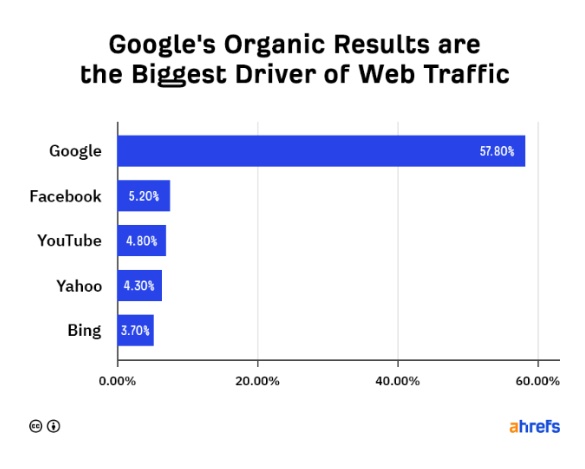
Źródło: https://twitter.com/ahrefs/status/1397961681976844295
Pozycjonowanie – na czym polega?
Pozycjonowanie stron to zespół działań, dzięki którym strona zwiększa widoczność w wynikach wyszukiwania na frazy kluczowe. Oznacza to dążenie do uzyskania jak najwyższej pozycji na wysyłane przez internautę zapytania, opisujące Twój biznes. Aby osiągnąć taki rezultat, trzeba zoptymalizować stronę pod wymagania algorytmu Google. O widoczności decyduje wiele czynników m.in. dopracowanie treści, rozwój profil linkowego i wyeliminowanie błędów technicznych. Strona WWW nie osiągnie oczekiwanej widoczności z dnia na dzień. Czas potrzebny na uzyskanie wysokich pozycji zależy od reputacji domeny, konkurencji w danej branży czy stanu serwisu.
Dlaczego warto zdecydować się na pozycjonowanie? Gdyż widoczność w Google zapewnia ruch na stronie i klientów. Z badania przeprowadzonego przez HubSpot wynika, że dla 60% marketerów to jedno z najskuteczniejszych źródeł pozyskiwania wysokiej jakości leadów.
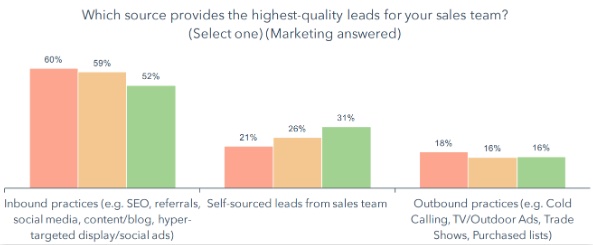
Źródło: https://cdn2.hubspot.net/hubfs/3476323/State+of+Inbound+2018+Global+Results.pdf
Optymalizacja strony pod wymagania Google jest w dużej mierze spójna z dostosowaniem witryny do oczekiwań użytkowników. Dlaczego działania prowadzi się właśnie pod tę wyszukiwarkę?
Pozycjonowanie w Google – dlaczego akurat ta wyszukiwarka?
Google jest zdecydowanym liderem na rynku wyszukiwania. Według Statcounter ma ponad 90% udziału. Drugą pozycję zajmuje Bing z wynikiem ponad 3%. Niewiele jest krajów, w których Google nie lideruje. Są nimi Chiny, Korea Północna i Południowa, a także Rosja.
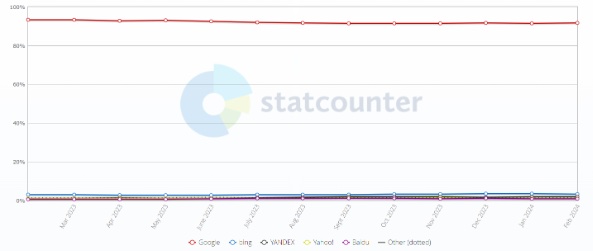
Źródło: https://gs.statcounter.com/search-engine-market-share
W Polsce Google jest zdecydowanym liderem z udziałem rynkowym powyżej 95%. Ponad 3% ma Bing, natomiast pozostałe wyszukiwarki – poniżej 1%. To właśnie popularność Google w Polsce powoduje, że pozycjonowanie stron WWW w naszym kraju skupia się na osiągnięciu wysokich pozycji w tej wyszukiwarce.
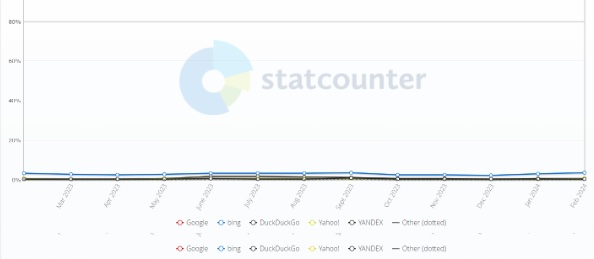
https://gs.statcounter.com/search-engine-market-share/all/poland
Czym się różni SEO od pozycjonowania?
SEO, czyli skrótowiec od Search Engine Optimization, oznacza optymalizację stron pod kątem wyszukiwarek internetowych. Natomiast pozycjonowanie to polskie pojęcie określające działania prowadzące do zwiększenia widoczności w SERP-ach (Search Engine Results Page). W obu przypadkach cel jest ten sam – osiągnięcie wyższej pozycji na zapytania i zwiększanie ruchu z Google. Jednak możesz się spotkać z różnym podejściem do tych pojęć. Część specjalistów uważa, że można je stosować zamiennie, a inni twierdzą, że SEO jest tylko elementem procesu pozycjonowania, który oznacza wyłącznie przeprowadzenie optymalizacji technicznej witryny. Z czego to się bierze? Z dosłownego interpretowania SEO. Search Engine Optimization jest często traktowane wyłącznie jako optymalizacja techniczna w ramach strony WWW. Tymczasem chodzi tutaj o coś więcej. Optymalizacja odnosi się do dostosowania witryny pod wszystkie czynniki rankingowe wyszukiwarki Google i obejmuje także pozyskiwanie linków prowadzących do strony.
Na świecie używa się pojęć SEO i Web Positioning jako synonimy. To drugie jest rzadko wykorzystywane. Zwróć uwagę, że obowiązuje podział na:
- SEO on-site – działania w obrębie witryny, np. optymalizacja techniczna,
- SEO off-site – działania poza stroną, czyli przede wszystkim link building.
Zatem wynika z tego, że SEO obejmuje jedne i drugie działania. Mimo wszystko w Polsce wielu specjalistów twierdzi, że pozycjonowanie to ogół kroków zmierzających do osiągnięcia wysokich pozycji, a SEO – optymalizacja techniczna. Co ciekawe, definicja, która znajduje się w Wikipedii, wskazuje, że używanie tych pojęć zamiennie jest błędem. Spór o tę kwestię trwa od lat. Jeśli zlecasz pozycjonowanie, powinno Cię interesować głównie to, czy oferta obejmuje wszystkie działania niezbędne do optymalizacji witryny i rozwijania jej widoczności w Google. Nazewnictwo nie odgrywa istotnej roli.

Źródło: https://pl.wikipedia.org/wiki/Optymalizacja_dla_wyszukiwarek_internetowych
Jakie są rodzaje pozycjonowania w Google?
Wyróżnić można kilka typów pozycjonowania w zależności od tego, jakie frazy obejmuje, a także do kogo kierowana jest oferta. Działania, które w poszczególnych przypadkach zmierzają do osiągnięcia wysokich pozycji, są podobne, ale różnią się skalą trudności – budżetu potrzebnego, aby w ogóle kampania mogła przynieść oczekiwane efekty. Jakie są rodzaje pozycjonowania i czym się różnią?
Pozycjonowanie ogólnopolskie
To działania realizowane dla firm, które kierują swoją ofertę do mieszkańców całej Polski. Doskonałym przykładem są sklepy internetowe. Przeważnie pozycjonowanie ogólnopolskie jest trudne, gdyż w sieci działa wiele firm o podobnym profilu i ofercie. Nie oznacza to, że musisz celować wyłącznie we frazy ogólnopolskie. Mogą to być frazy krótkie, składające się z jednego słowa, np. “pralka”, ale również – “pralka ładowana od góry do 2000 zł”. W pierwszym przypadku masz do czynienia z bardzo konkurencyjną frazą, gdzie uzyskanie wysokiej pozycji jest trudne, ale może przełożyć się na duży ruch. Z drugiej strony takie zapytanie nie przekazuje intencji – trudno powiedzieć, czy internauta chce kupić pralkę, czy jednak interesuje go kolorowanka dla dziecka, a może instrukcja naprawy. Natomiast w przypadku drugiej z wymienionych fraz możesz uzyskać zdecydowanie mniejszy ruch, ale za to skuteczniejszy – internauta prawdopodobnie szuka sprzętu, który chce kupić.
Pozycjonowanie międzynarodowe
Te działania celują w pozyskanie ruchu organicznego z różnych krajów. Jeśli chcesz odnieść sukces w międzynarodowym SEO, musisz dostosować się do kontekstu kulturowego rynku docelowego i umożliwić klientom dokonywanie transakcji w ich walucie i języku.
Używaj odpowiedniego formatu dat i godzin w zależności od miejsca, w którym znajdują się odbiorcy. Pozycjonowanie międzynarodowe ma na celu stworzenie dobrego doświadczenia online dla użytkowników witryny. W tym przypadku konieczna jest analiza słów kluczowych dla poszczególnych rynków. Nie zawsze frazy przetłumaczone dosłownie będą przynosić konwertujący ruch w przypadku odbiorców z różnych krajów.
Przeważnie chodzi tutaj o pozycjonowanie sklepu internetowego, który ma ofertę kierowaną do odbiorców zagranicznych. Takie działania prowadzą również firmy, które mają zagraniczne oddziały i realizują usługi w różnych krajach.
Pozycjonowanie lokalne
Ten rodzaj pozycjonowania kierowany jest do firm, które szukają klientów wśród mieszkańców danego miasta, gminy czy powiatu. Zerknij na poniższy wykres. Według BrightLocal aż 98% internautów szuka w Google informacji na temat lokalnego biznesu. To podstawowe źródło pozyskiwania wiedzy o usługodawcach i punktach sprzedaży detalicznej.
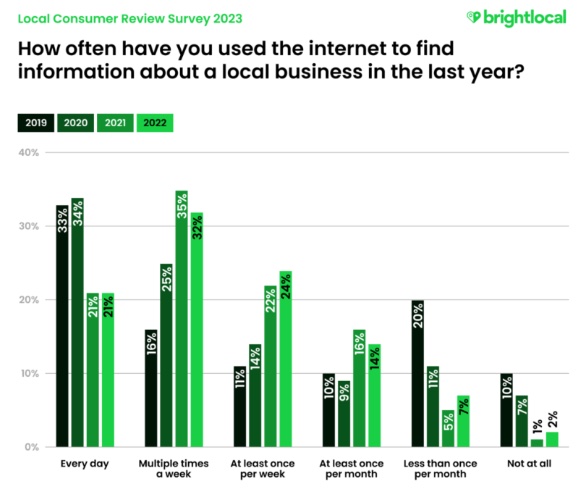
Źródło: https://www.onthemap.com/blog/local-seo-stats/
Pozycjonowanie lokalne obejmuje nie tylko stronę. Zwróć uwagę, że w wynikach wyszukiwania na zapytania lokalne, zaraz pod reklamami z Google Ads, znajduje się zazwyczaj tzw. trzypak z Google Maps. Wygląd to tak, jak na poniższej grafice:

Twoja marka może być widoczna więcej niż jeden raz w wynikach lokalnych. Aby jednak pojawiła się także w trzypaku, załóż najpierw Profil Firmy w Google. Oczywiście, wymaga on optymalizacji i systematycznego aktualizowania, aby wizytówka mogła być widoczna na wysokiej pozycji.
W przypadku zapytań lokalnych przeważnie konkurencja jest dużo mniejsza niż w ramach zapytań ogólnych, ale jeśli działasz w dużym mieście, to i tak jej pokonanie może być trudne.
Pozycjonowanie szerokie
W tym przypadku działania SEO skupiają się na frazach, które składają się z co najmniej 3 słów. Możesz zdecydować się na pozycjonowanie witryn nawet na tysiące takich słów kluczowych. Osiągnięcie w ich przypadku pozycji w top 10 Google nie jest zazwyczaj trudne, ale musisz mieć świadomość, że miesięczna liczba wyszukiwań również nie jest wysoka. Fakt, że zapytanie składa się z kilku słów, powoduje, że internauta dokładniej opisuje to, czego szuka i wiadomo, na jakim etapie realizacji określonego celu się znajduje. Dlatego takie zapytania charakteryzują się wysokim wskaźnikiem konwersji. Według analizy Backlinko ponad 90% słów kluczowych wyszukiwanych w Google to frazy long tail. Zerknij na poniższy wykres:
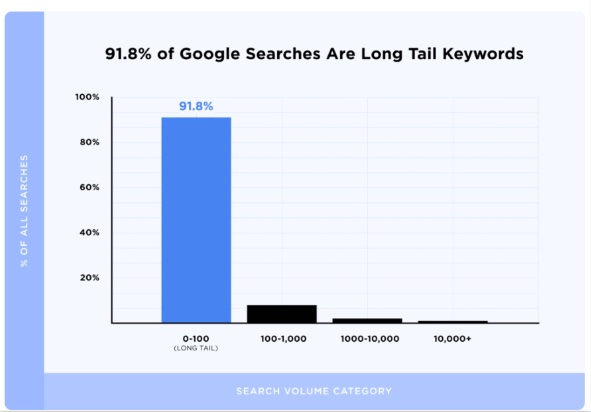
Źródło: https://backlinko.com/google-keyword-study
Frazy typu long tail zostały opisane w precyzyjny sposób na poniższej grafice. Krótkie zapytania, po zdobyciu wysokiej pozycji w Google mogą pozyskiwać duży ruch, ale też są bardzo konkurencyjne. Natomiast frazy typu long tail są stosunkowo łatwe pod względem zdobycia wysokich pozycji, ale też zapewniają wysoką konwersję. Dlatego zdecydowanie warto na nie stawiać. W wielu przypadkach możliwe, że stosunkowo szybka optymalizacja strony internetowej wystarczy, żeby uzyskać zadowalającą widoczność na dane zapytanie.
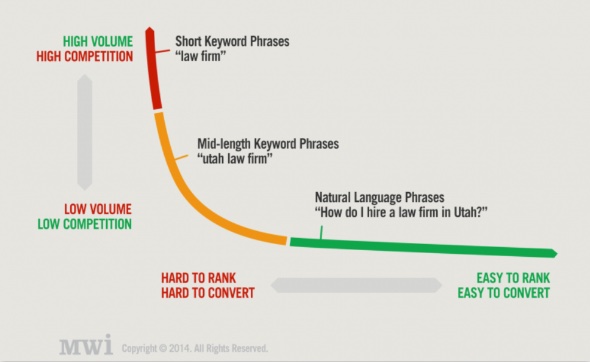
Źródło: https://profitworks.ca/blog/488-conversions-of-longtail-keywords-are-2-5x-higher-than-head-keywords
Oczywiście, nic nie stoi na przeszkodzie, aby dla danej witryny prowadzić pozycjonowanie ogólne, lokalne i szerokie. Takie połączenie może przynieść znakomite efekty.
Pozycja w wynikach wyszukiwania
Celem pozycjonowania jest rozwijanie widoczności na frazy w Google, a także uzyskanie wysokich pozycji na konkretne frazy. Im witryna znajduje się wyżej na dane zapytanie, tym większa szansa na kliknięcie. Osiągnięcie pierwszej pozycji nie oznacza jednak, że każdy, kto wyszuka dane słowo kluczowe, trafi na Twoją witrynę. Zwróć uwagę, że w zależności od zapytania rezultaty się różnią. W wynikach pojawiają się m.in. zdjęcia, newsy, wideo, rezultaty z Google Maps i inne. Według Backlinko witryna, która znajduje się na pozycji 1, średnio osiąga CTR w wysokości 27,6%. To oznacza, że ten wynik klika mniej więcej 28 na 100 użytkowników, którzy wysłali dane zapytanie.

Źródło: https://backlinko.com/google-ctr-stats
Witryna, która znajduje się na pozycji 10 może liczyć na 2-3 odwiedziny. Dlatego tak duże znaczenie ma osiąganie jak najwyższej pozycji. W przypadku mało popularnych fraz jakiekolwiek przekierowania z wyników wyszukiwania mogą pojawić się dopiero po osiągnięciu top 3. Ogólnie ponad połowa ruchu z rezultatów organicznych trafia do witryn, które zajmują miejsca od 1 do 3. Poniższy wykres pokazuje, jak zmienia się CTR po osiągnięciu wyższej pozycji.

Źródło: https://backlinko.com/google-ctr-stats
Różnica w wysokości CTR występuje również w zależności od tego, z jakiego urządzenia korzysta internauta. Przeważnie inna jest w przypadku komputerów, a inna, jeśli chodzi o sprzęty przenośne. Pamiętaj, że CTR możesz poprawić nie tylko poprzez osiągnięcie wyższej pozycji. Warto korzystać z danych strukturalnych na stronie, dzięki czemu w wynikach wyszukiwania mogą pojawić się dodatkowe elementy, który wyróżniają Twoją witrynę. Do tego możesz także przetestować zastosowanie kolorowych piktogramów – emotikonów. Jeśli Google je wyświetli w wynikach, one również mogą przyczynić się do wzrostu CTR.
Dlaczego warto zainwestować w pozycjonowanie w Google?
Jeśli zdecydujesz się na pozycjonowanie strony w wyszukiwarce, możesz zdobyć klientów, dotrzeć do nowych odbiorców oferty i zoptymalizować witrynę tak, aby spełniała oczekiwania algorytmu wyszukiwarki Google, a także użytkownika. Strona będzie nowoczesna i zapewni internautom pozytywne doświadczenia. Przyjrzyj się bliżej, jakie korzyści możesz odnieść, jeśli przeprowadzisz optymalizację SEO. Co daje skuteczne pozycjonowanie?
Zwiększysz liczbę odwiedzających stronę WWW
Według SparkToro 92,96% globalnego ruchu pochodzi z wyszukiwarki Google, Google Grafika i Map Google. Jeśli pomijasz pozycjonowanie, rezygnujesz ze źródła ruchu, które może zapewnić mnóstwo odwiedzin Twojej stronie. W ramach skutecznie realizowanej kampanii liczba odwiedzin powinna regularnie rosnąć, a witryna – zyskiwać widoczność na coraz więcej fraz.
Zdobędziesz klientów
Jedną z największych zalet pozycjonowania jest docieranie do internautów, którzy są zainteresowani Twoją ofertą. Wysłali zapytanie, Google dopasowało wynik i uzyskali najprawdopodobniej to, czego szukali. Pozycjonowanie WWW charakteryzuje wysoki wskaźnik konwersji. Poniższa tabela pokazuje, ile wynosi dla branż B2C i B2B. W przypadku B2B SEO uzyskało najwyższy wynik, a B2C – jeden z najwyższych:
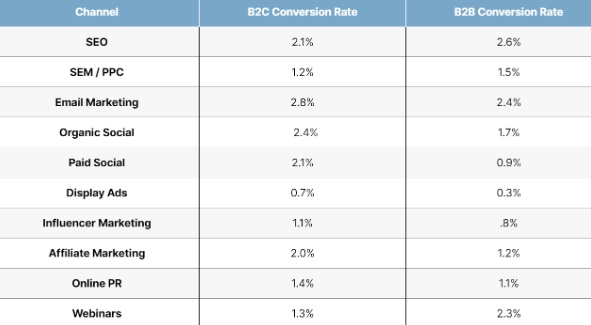
Źródło: https://firstpagesage.com/reports/digital-marketing-conversion-rate/
Strona dostosowana do oczekiwań algorytmu Google i użytkowników
Jak wiesz, efekt pozycjonowania zależy w dużej mierze od optymalizacji strony pod wymagania wyszukiwarki Google. To jednak nie oznacza, że Twoja strona WWW będzie nieatrakcyjna dla użytkownika. Oczekiwania algorytmu Google są w dużej mierze spójne z wymaganiami internauty. Oto wybrane elementy, które mają znaczenie:
- Szyfrowane połączenie – Google od lat zachęcało do korzystania z niego i dopięło swego, gdyż obecnie ponad 80% wszystkich witryn używa SSL. Oznacza to, że połączenie między stroną a użytkownikiem jest szyfrowane (tzn. bezpieczne). Dane nie będą przejęte ani zmienione przez niepowołane osoby. Adres takiej witryny zaczyna się od https://.
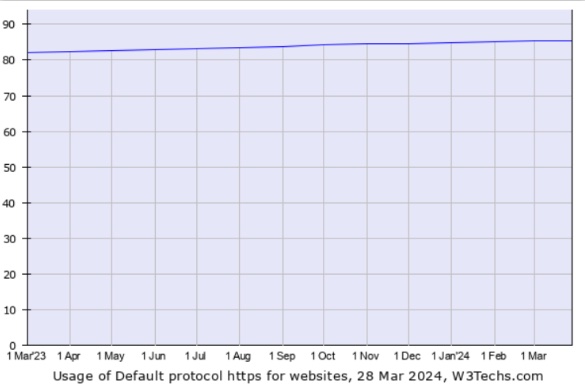
Źródło: https://w3techs.com/technologies/details/ce-httpsdefault
- Strona responsywna – witryna powinna być dopasowana do wyświetlania na ekranach o różnej rozdzielczości. To istotne dla Google i niezbędne dla użytkownika, gdyż korzystanie z witryny, która nie wyświetla się prawidłowo, jest bardzo niewygodne. Trudno oczekiwać, aby w takim przypadku pozostał na stronie, a tym bardziej zamówił na niej produkt.
- Szybkość ładowania – internauci oczekują, że witryna będzie działać ekspresowo. Im ładuje się szybciej, tym lepiej. To jeden z czynników, które mają wpływ na pozycje strony internetowej w Google. Nawet pomijając tę kwestię, warto posiadać szybką witrynę ze względu na wpływ na konwersję. Poniższy wykres prezentuje wyniki badań, które potwierdzają, że im wyższy wskaźnik konwersji, tym wyższa konwersja.
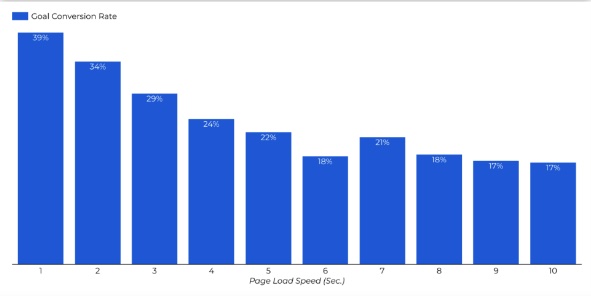
Źródło: https://www.portent.com/blog/analytics/research-site-speed-hurting-everyones-revenue.htm
- Przemyślana struktura strony – witryna powinna mieć tak opracowane drzewo kategorii, aby użytkownik bez problemu znalazł to, czego szuka. Ważne jest odpowiednie nazewnictwo. Dopracowane menu i odpowiedni układ wpływają na pozycjonowanie strony. Po pierwsze, nazwy muszą być spójne z frazami, które internauci wyszukują w Google. Robot wyszukiwarki powinien bez problemów dotrzeć do kategorii i stron produktowych. Każdą podstronę w serwisie, która zawiera treści dla użytkownika i ma być zindeksowana przez Google, podlinkuj z przynajmniej kilku podstron.
- Linkowanie wewnętrzne – dzięki linkowaniu wewnętrznemu Google bierze pod uwagę poszczególne treści, tzn. robot w ogóle jest w stanie do nich dotrzeć. W ramach optymalizacji SEO należy dopracować je, np. poprzez linkowanie do poszczególnych produktów ze wpisów blogowych, opisów kategorii, podkategorii czy podstron, na których porównujesz oferowane artykuły. Dla każdej podstrony w serwisie z pewnością znajdziesz odpowiednie URL-e, z których możesz linkować.
- Zastosowanie danych strukturalnych – dzięki temu ułatwiasz wyszukiwarce Google ustalenie, co oznacza dana treść. Możesz określić, że dana informacja oznacza cenę, stan magazynowy czy nazwę marki. W efekcie informacje mogą pojawić się w wynikach Google. To elementy, które zwracają uwagę z wyniku wyszukiwania, są cenne dla użytkownika i mogą zwiększyć szanse na to, że odwiedzi Twoją witrynę.
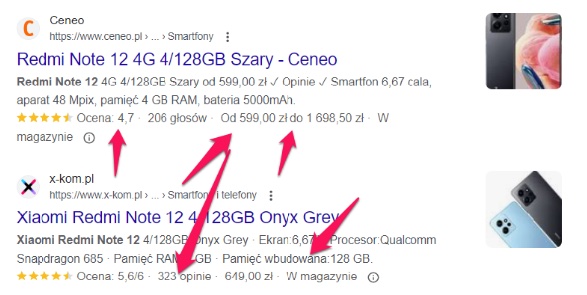
- Spis treści w artykułach – dodaj w publikowanych wpisach blogowych taki spis z linkami z kotwicami prowadzącymi do poszczególnych nagłówków. To bardzo wygodne rozwiązanie dla internautów, którzy przeglądają witrynę naurządzeniach przenośnych. Dzięki temu nie muszą scrollować, aby dotrzeć do interesujących treści, tylko klikają w spisie dany nagłówek i docierają do tego contentu, który chcą przeczytać. Możesz również zwiększyć szanse na kliknięcia z wyników wyszukiwania, gdyż pod wynikiem mogą pojawić się także dodatkowe linki.
Jak widzisz optymalizacja pod kątem pozycjonowania stron internetowych w Google jest w dużej mierze spójna z projektowaniem witryny w taki sposób, aby spełniała oczekiwania użytkownika.
Audyt SEO – zanim rozpocznie się pozycjonowanie strony WWW
Zanim rozpocznie się proces pozycjonowania i optymalizacji SEO, trzeba sprawdzić stan witryny. Audyt SEO pozwala ocenić dopracowanie witryny pod kątem wyszukiwarek. Trzeba ustalić jej mocne i słabe strony. Kluczową rolę odgrywa identyfikacja błędów, które mogą uniemożliwić witrynie uzyskanie oczekiwanej widoczności w wynikach wyszukiwania. W ramach tych działań należy również ocenić stan konkurencji, co pozwoli ustalić, ile czasu będzie wymagać pozycjonowanie witryny w Google, a także z jaką będzie się wiązać inwestycją. Aby wyprzedzić inne witryny, serwis musi być dopracowany i ogólnie lepszy pod względem SEO. Zazwyczaj audyt SEO obejmuje architekturę witryny, jej kod, indeksowanie, optymalizację treści pod słowa kluczowe, linkowanie wewnętrzne, profil linków zwrotnych i wiele innych elementów. Jako agencja SEO wykonujemy kompleksową analizę stanu witryny, wyciągamy wnioski i na tej podstawie opracowujemy strategię SEO. W jakim zakresie sprawdzamy stan witryny?
Sprawdzenie błędów indeksowania
To one mogą odpowiadać za problemy w serwisie. Mieliśmy już do czynienia z witrynami klientów, których w ogóle nie było w indeksie Google ze względu na użycie w kodzie tagu wykluczającego indeksowanie. Sprawdzimy, jak Twoja witryna wygląda pod tym kątem w Google Search Console, ale korzystamy również z innych narzędzi, takich jak m.in. Screaming Frog i Ahefs. Na tej podstawie analizujemy, jakie występują problemy w witrynie. Częstymi są błędy 404 (linkowanie do nieistniejących podstron w serwisie), pętle przekierowań czy wykluczenia indeksowania istotnych podstron w serwisie. To one mogą powodować, że Twojej strony nie ma w wyszukiwarce Google. Wyeliminowanie tych błędów jest w stanie szybko przynieść diametralną poprawę widoczności witryny.
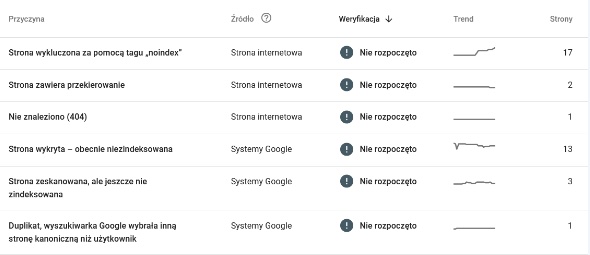
Przekierowania stron
Dla Google adresy http://onet.pl i http://www.onet.pl są różne. Tym samym w indeksie wyszukiwarki może się znajdować dokładnie ta sama treść zindeksowana kilkukrotnie. o z kolei powoduje problemy z indeksowaniem i pozycjonowaniem – zwłaszcza że Google uzna je za duplikaty. Problem może wynikać również z tego, że przy wprowadzaniu szyfrowanej wersji witryny (https://) osoba odpowiedzialna za to nie dodała przekierowania 301 z adresu z http://. Problemem są również pętle przekierowań. Nie powinno być tak, że strona A jest przekierowana na B, B na C, a C na D. Należy bezpośrednio przekierować z A na D, gdyż w przeciwnym wypadku po drodze traci część „mocy” SEO. Poza tym przy takiej pętli robot Google może mieć problem z dotarciem do docelowego adresu URL.
Sprawdź działania ręczne
Jeśli witryna narusza zasady Google dotyczące spamu, może otrzymać ręczną karę. Oznacza to, że witryna może zniknąć z wysokich pozycji na słowa kluczowe. Dopóki Google nie cofnie tych działań, sytuacja nie zacznie się poprawiać. Obecnie wyszukiwarka nie nakłada często takich kar, ale nada się zdarzają. Przyczynami mogą być: upychanie słów kluczowych, witryna zawiera wyłącznie spam – nie ma na niej wartościowej treści. Inne powody to prowadzące do niej niskiej jakości linki czy też to witryna będąca efektem treści generowanych automatycznie przez AI. Jeśli Google nie nałożyło kary ręcznej, w Google Search Console znajdziesz taki komunikat jak poniżej:

Podstawowe wskaźniki internetowe
Core Web Vitals to zestaw wskaźników, które dotyczą wydajności i szybkości działania witryny. Od kilku lat są czynnikiem rankingowym, tzn. mają wpływ na widoczność strony w Google. Sprawdzimy, czy witryna spełnia pod tym kątem wymagania algorytmu. Z Google Search Console możesz dowiedzieć się, jakie problemy występują w przypadku Twojej witryny. Idealnie, jeśli nie wymaga żadnej poprawy pod tym kątem. Stronę możesz również zweryfikować pod adresem pagespeed.web.dev/.

Wersja szyfrowana strony
Twoja witryna powinna obowiązkowo korzystać z certyfikatu SSL, tzn. szyfrowanego połączenia. Ważne, aby nie występowały żadne błędy. Zdarza się, że niektóre odnośniki w witrynie nie mają prawidłowo podmienionych na takie, które prowadzą do wersji z https://. Może to również dotyczyć linków do zdjęć. W Google Search Console możesz sprawdzić witrynę również pod tym kątem. Jeśli występują błędy, trzeba je szybko wyeliminować.
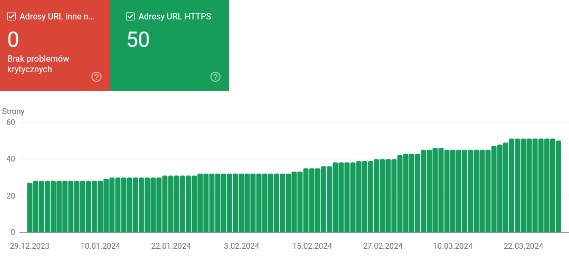
Analiza linkowania wewnętrznego
Struktura strony, drzewo kategorii w menu i podlinkowanie poszczególnych podstron w serwisie, mają ogromny wpływ na widoczność Twojej witryny. SEO i pozycjonowanie wymagają zwrócenia na te elementy szczególnej uwagi. Każda treść, która ma zajmować wysokie pozycje w wynikach wyszukiwania, powinna być podlinkowana z co najmniej kilku innych materiałów w serwisie. Linki wewnętrzne na swojej stronie możesz umieścić w artykułach na blogu, opisach kategorii, podkategorii, a nawet w treściach produktowych.
To elementy, które wpływają nie tylko na widoczność strony – dzięki nim internauta może łatwiej dotrzeć do interesującej go treści, co z kolei zwiększa szansę na pozostanie dłużej na stronie i konwersję. Linki wewnętrzne pomagają wyszukiwarkom indeksować witrynę i kierować tzw. link juice do najważniejszych stron. Możesz wykorzystywać do linkowania wewnętrznego przeróżne narzędzia, ale jednak najlepsze efekty przynosi ręczna praca. Poza tym nie ryzykujesz, że, np. awaria wtyczki, spowoduje automatyczne zniknięcie wszystkich takich odnośników w serwisie.
Duplikacja treści
Google docenia witryny internetowe, które zapewniają unikatowy, wartościowy content. Nie nałoży kary na Twoją stronę za pojedynczą kopię treści, ale masowe naruszanie tej zasady może się skończyć problemami dla domeny. Możliwe są dwa rodzaje duplikacji – wewnętrzna i zewnętrzna. Pierwsza z nich oznacza, że na wielu podstronach serwisu występuje identyczna treść. Zazwyczaj wynika to z błędów w serwisie, np. niepoprawnie wdrożonych przekierowań, przez które ta sama podstrona jest widoczna dla robota Google pod różnymi adresami, np. https://onet.pl i http://onet.pl, lub braku wdrożenia odpowiednich linków kanonicznych, czyli takich, które wskazują, pod jakim adresem URL znajduje się oryginalna treść. Dotyczy to szczególnie opisów kategorii, które wyświetlają się na wielu podstronach paginacji. Jeśli chcesz sprawdzić, czy na Twojej stronie występuje wewnętrzna duplikacja, skorzystaj z narzędzia Siteliner, które w ograniczonym zakresie jest bezpłatne. Optymalizacja witryny pod tym kątem jest elementem on-site SEO.
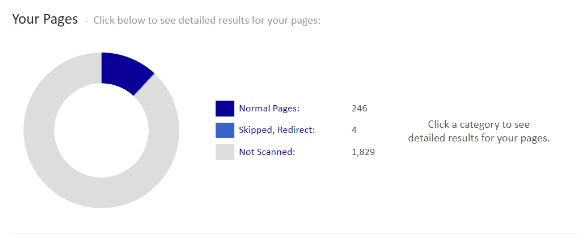
Źródło: https://www.siteliner.com/
W przypadku duplikacji zewnętrznej chodzi natomiast o używanie tej samej treści na różnych stronach. Często wynika to z korzystania z opisów produktów udostępnianych przez producenta. Nie jest to dobry pomysł. Jeśli zerkniesz do wyników wyszukiwania Google, prawdopodobnie nie znajdziesz na wysokich pozycjach witryn, które mają skopiowane opisy.
Kolejnymi częstymi przyczynami zewnętrznej duplikacji są używanie treści z Twojej strony w profilach w serwisach społecznościowych, ogłoszeniach, na aukcjach czy w Profilu Firmy w Google (Google Moja Firma). Nie warto tego robić, gdyż konsekwencją może być zajmowanie na daną frazę wyższej pozycji przez, np. aukcję na Allegro – Twoja strona będzie na niższej ze względu na reputację domeny tego serwisu aukcyjnego. Nie ma tutaj znaczenia, że wcześniej udało się dodać tę treść na swojej stronie internetowej. Warto monitorować unikatowość contentu. Może się zdarzyć, że ktoś goukradnie z Twojej witryny – wykorzysta bez pozwolenia. W takim przypadku żądaj natychmiastowego usunięcia, ale też możesz zgłosić naruszenie do Google pod adresem: support.google.com/legal/troubleshooter/1114905?hl=pl.
Analiza backlinków prowadzących do witryny
Pozycjonowanie stron w Google wymaga pozyskiwania linków prowadzących do witryny. Jednym z elementów audytu jest analiza ich profilu. Odnośnik może pozytywnie wpływać na widoczność witryny albo wręcz przeciwnie. Profil linków wymaga dokładnej analizy. Zdarzają się przypadki, w których do witryny prowadzi ogromna liczba odsyłaczy pochodzących ze spamu. W skrajnych przypadkach jakiekolwiek działania dla tej witryny mogą okazać się nieopłacalne, gdyż nie przyniosą żadnej zmiany.
Skuteczne pozycjonowanie stron internetowych bazuje na wysokiej jakości odnośnikach. Profil linków oceniamy m.in. pod względem zróżnicowania anchorów, czyli tytułów odsyłaczy. Jeśli do witryny prowadzą w większości odnośniki z takimi anchorami jak pozycjonowane frazy (exact match), to może bardzo negatywnie wpływać na jej widoczność. Dbamy o zróżnicowanie profilu, ale przede wszystkim o jakość odsyłaczy. Jeśli chodzi o pozycjonowanie off-site, odnośniki są kluczowym elementem. Celem nie powinno być pozyskiwane ich w jak największej liczbie, ale jakość. Warto stawiać na linki z witryn powiązanych tematycznie, rozwijanych, aktualizowanych i zawierających wartościowe treści. To może pozytywnie wpłynąć na widoczność. Analizujemy odnośniki m.in. w narzędziu Ahrefs, ale również sprawdzamy linki w Google Search Console i innych narzędziach, takich jak Majestic SEO. Czy rzeczywiście odnośniki są tak ważne? Z analizy przeprowadzonej przez Ahrefs wynika, że podstrony z większą liczbą odnośników są widoczne na większą liczbę słów kluczowych w wynikach wyszukiwania.
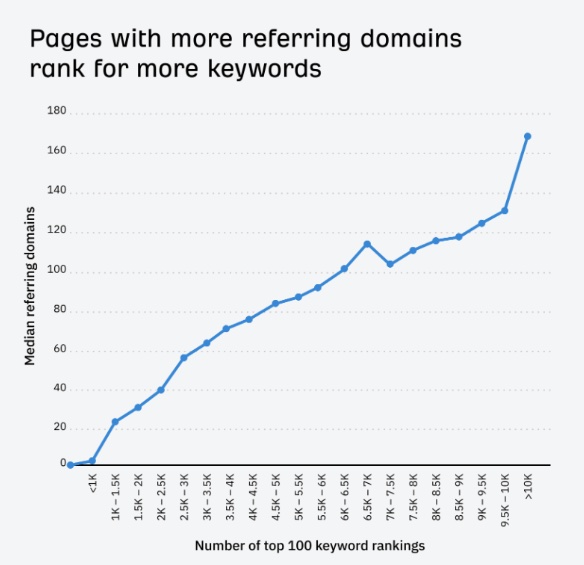
Źródło: https://ahrefs.com/blog/search-traffic-study/
Słowa kluczowe i ich zastosowanie
Specjalista SEO wiele uwagi poświęca analizie treści na stronie. To w nich może tkwić przyczyna problemów z widocznością w Google. Strategia pozycjonowania powinna obejmować analizę słów kluczowych dla każdego contentu w witrynie. Dla wszystkich należy przygotować listę słów kluczowych, które następnie powinny być odpowiednio wykorzystane w poszczególnych treściach. Sama optymalizacja contentu pod kątem SEO może przynieść diametralną zmianę widoczności.
Przy tworzeniu contentu warto wykorzystać takie narzędzia jak: Contadu, Surfer SEO czy Neuron Writer. Podpowiadają one, jakie frazy powinna zawierać treść, sugerują nagłówki, długość artykułu i nie tylko – a wszystko na podstawie analizy treści zajmujących wysokie pozycje. SEO copywriting powinien również obejmować analizę słów kluczowych w innych narzędziach, np. Senuto czy Semstorm, dzięki którym możesz wpaść na dodatkowe pomysły nagłówków, które warto umieścić w treści. Sprawdź, jaki content pojawia się w pozycji Więcej pytań w Google na istotne dla Ciebie zapytania. Uzupełnij artykuł o odpowiedzi na te pytania. Tak naprawdę praca nad optymalizacją contentu nigdy się nie kończy, gdyż wciąż pojawiają się nowe zapytania, na które warto odpowiedzieć albo dodać w treści słowa kluczowe. To pozwala wciąż rozwijać widoczność artykułu.
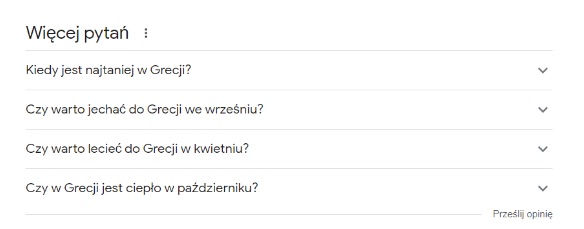
Pozycjonowanie stron internetowych a rodzaje słów kluczowych
Nieodłącznym elementem w pozycjonowaniu jest optymalizacja pod słowa kluczowe. Fraz używa się jednak nie tylko w contencie na stronie, ale również jako anchor linków prowadzących do witryny. W praktyce możesz zastosować różne typy słów kluczowych.
Frazy kluczowe krótkiego ogona
Chodzi tutaj o frazy, które składają się z maksymalnie dwóch słów. Są bardzo ogólnikowe, np. buty, kredyty, kredyty gotówkowe, sukienki, narty. Nie wiadomo, jakie są intencje użytkownika, który wyszukuje takie zapytanie. Przeważnie nie korzystają z nich internauci zdecydowani na zakup. W praktyce trudno przewidzieć, jakie są ich intencje. Ktoś, kto wpisuje zapytanie kredyty, może w ogóle nie myśleć o zaciągnięciu takiego zobowiązania, a szuka definicji tego produktu bankowego. Gdybym jednak to było zapytanie „kredyt gotówkowy online do 10 tys.”, to już raczej chodzi o znalezienie konkretnego produktu. Decydując się na pozycjonowanie takich fraz, miej na uwadze, że są bardzo konkurencyjne. Mogą wymagać bardzo wysokiego budżetu, ale po osiągnięciu pozycji w top 10, będą przynosić stosunkowo duży ruch. Problem tkwi jednak w tym, że wskaźnik konwersji w ich przypadku może być niski.
Frazy kluczowe z długiego ogona
O tych zapytaniach już wspominaliśmy. W tym przypadku chodzi o frazy, które składają się z co najmniej 3 słów. Jeśli zależy Ci na skutecznym SEO, które jak najszybciej zacznie przynosić zwrot z inwestycji w pozycjonowanie swojej strony WWW, postaw na te frazy od początku działań. O ile na wysokie pozycje w przypadku zapytań z krótkiego ogona możesz czekać długo, o tyle efekty długiego ogona mogą być widoczne ekspresowo. Wprawdzie takie frazy kluczowe mają niewielki wolumen wyszukiwań, ale możesz doprowadzić witrynę do widoczności na setki czy tysiące zapytań, co przełoży się na duży ruch. Co istotne, frazy składające się z wielu słów lepiej opisują oczekiwania użytkownika, co zwiększa szanse na konwersję. Dlatego warto od samego początku prowadzenia działań stawiać na takie zapytania.
Brandowe słowa kluczowe
Internauci często wyszukują określoną markę albo łączą nazwę brandu ze słowem kluczowym. W takich przypadkach duża część odwiedzin na stronie może się kończyć konwersją, gdyż użytkownik szuka oferty konkretnej marki. Zazwyczaj osiągnięcie widoczności na takie frazy jest pozytywnym efektem ubocznym w SEO. Jeśli rozwijasz witrynę, budujesz jej profil linkowy, najprawdopodobniej szybko będzie zajmować wysokie pozycje na brandowe słowa kluczowe. Często nawet nazwa marki nie musi pojawiać się w tytule strony (tagu title), przy czym oczywiście naturalne, że tam się znajduje.
Lokalne słowa kluczowe
W tym przypadku chodzi o frazy związane z daną lokalizacją. Znajdują zastosowanie w przypadku firm, które kierują swoją ofertę do mieszkańców określonego miasta, dzielnicy, powiatu czy gminy. Jeśli chcesz dotrzeć do klientów z różnych miast, utwórz oddzielne landing page dla każdej z tych miejscowości, a następnie zoptymalizuj treść pod zapytania lokalne. Używaj słów kluczowych w połączeniu z daną lokalizacją. Dużą zaletą pozycjonowania witryny na takie słowa kluczowe jest stosunkowo mała konkurencyjność. Jeśli posiadasz witrynę, która ma dobrą widoczność w Google, to pozycjonowanie Twojej strony na frazy związane z innymi miastami powinno być stosunkowo łatwe. W wielu przypadkach wystarczy dodanie zoptymalizowanej podstrony, podlinkowanie wewnętrzne, aby osiągnąć oczekiwane wyniki. Kolejną dużą zaletą takich fraz jest wysoka konwersja. Jeśli ktoś szuka zapytania, które składa się z nazwy produktu/usługi połączonego z lokalizacją, to prawdopodobnie chce je kupić.
Ile kosztuje pozycjonowanie?
Nie da się udzielić jednoznacznej odpowiedzi na pytanie o to, ile kosztuje optymalizacja i pozycjonowanie. Badanie na ten temat przeprowadziło Ahrefs. Okazuje się, że większość firm płacących miesięczne wynagrodzenie za pozycjonowanie stron wydaje od 500 do 1500 dolarów. W przypadku rozliczających się stawką godzinową standardem jest 75-100 USD. Za jednorazowe projekty SEO najczęściej płaci się od 2501 do 5000 dolarów. Są i takie firmy, które inwestują w widoczność strony w wyszukiwarce powyżej 25 tys. dolarów miesięcznie. Duży odsetek respondentów przeznacza na ten cel od 2,5 do 5 tys. dolarów miesięcznie.
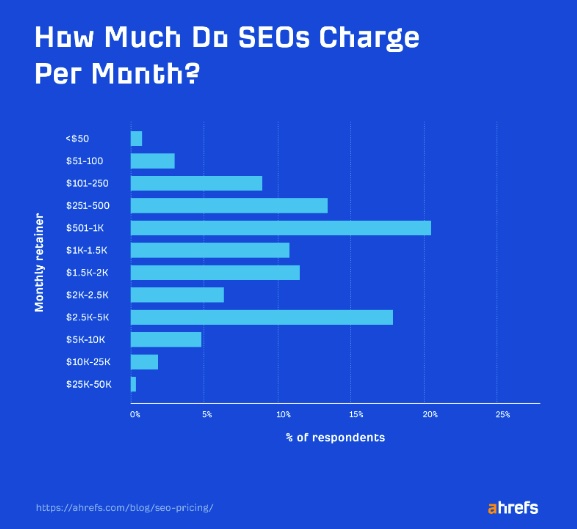
Źródło: https://ahrefs.com/blog/seo-pricing/
Ile zatem kosztuje skuteczne pozycjonowanie witryny w wyszukiwarce? Miesięczny wydatek zależy od wielu czynników. Kluczowe znaczenie ma konkurencja. W przypadku najbardziej dochodowych branż, takich jak finansowa czy ubezpieczeniowa, trzeba przygotować się na większy wydatek. Jeśli chcesz zainwestować w skuteczne pozycjonowanie w wyszukiwarkach w takich działalnościach, musisz się uzbroić w cierpliwość i posiadać wysoki budżet na SEO. Konkurencja jest w nich tak duża, że nawet frazy long tail bywają mocno wymagające, ale osiągnięcie wysokich pozycji może przynieść znaczący zwrot z inwestycji.
Duży wpływ na cenę na pozycjonowanie stron w internecie ma reputacja Twojej domeny i przewidywany zakres modyfikacji. Jeśli ma fatalny profil linkowy, to bardzo prawdopodobne, że dalsze inwestowanie w nią będzie zupełnie nieopłacalne. W takiej sytuacji lepszym wyborem może być założenie zupełnie nowej witryny, gdzie od początku dopracujesz wszystkie elementy, które mają wpływ na SEO. Witryna może mieć niskiej jakości treści i będzie wymagać zmiany wszystkich.
Różnica wynika również z tego, jakiego typu to pozycjonowanie. Globalne? Lokalne? A może chodzi wyłącznie o pozycjonowanie w Google Maps?
Kolejnym czynnikiem, który wpływa na koszty działań jest forma rozliczenia. Najpopularniejszym obecnie modelem jest abonament, co oznacza, że płacisz ustaloną kwotę miesięcznie i otrzymujesz w zamian określony zakres prac. Inna forma to płatność za efekt, tzn. ponosisz koszt wtedy, kiedy witryna zajmuje pozycję w top 10 na konkretne słowo kluczowe. Ustala się listę fraz i płaci dopiero, kiedy znajdzie się na te zapytania na wysokich pozycjach. Część zlecających decyduje się płacić za pozycjonowanie własnej strony za każdą godzinę realizowanych usług. Kupują wyłącznie konkretne realizacje i rozliczają się za nie. Często umowy zakładają dodatkowe opłaty za efekty pozycjonowania stron. Możesz takie ustalić, np. za określony ruch z Google czy też za osiągnięcie oczekiwanej widoczności w wynikach wyszukiwania.
Zanim w ogóle zabierzesz się za szukanie oferty w branży SEO, dowiedz się więcej o poszczególnych formach rozliczeń. Kompleksowe pozycjonowanie wymaga indywidualnego podejścia, a także dopasowanej indywidualnie formy rozliczeń.
Jakie formy rozliczeń oferują agencje SEO?
Wiesz już, czym jest pozycjonowanie i że możesz za nie płacić na różnych zasadach. Dowiedz się o poszczególnych modelach rozliczeń, aby wiedzieć, jakie wady i zalety mają poszczególne, a także która forma może być optymalna w przypadku Twojej działalności.
Pozycjonowanie stron w Google rozliczane abonamentowo
To obecnie zdecydowanie najczęściej wykorzystywany model. W tym przypadku ustalasz z wykonawcą usługi pozycjonowania jaki zakres prac będzie realizować i za ile. Przeważnie płacisz stałą kwotę, ewentualnie możecie ustalić, że wykonawca otrzyma premię, jeśli osiągnie dany rezultat. Firma SEO podejmuje działania, które mają wpływ na pozycjonowanie strony. Umowa obejmuje zazwyczaj: optymalizację techniczną, monitorowanie stanu serwisu, regularne rozwijanie contentu i link building. Zakres prac można dopasować indywidualnie do danego projektu. Natomiast powinien obejmować wszystkie działania, które są potrzebne do osiągnięcia oczekiwanej widoczności w wynikach wyszukiwania. Najczęściej umowa zawierana jest na czas nieokreślony z krótkim okresem wypowiedzenia. To bezpieczne rozwiązanie, gdyż możesz obserwować, czy działania przynoszą efekt i na tej podstawie zdecydować, czy chcesz je dalej prowadzić. A może warto zwiększyć budżet, aby osiągnąć jeszcze lepsze rezultaty? W przypadku umowy z taką formą rozliczenia firma SEO regularnie raportuje szczegóły działań. Obejmuje to statystyki z Google Analytics, dane z Google Search Console czy z narzędzi do analizy widoczności, takich jak Senuto czy Semstorm. Poza tym może wysyłać dane dotyczące zmian pozycji strony na wybrane frazy. Działania są nastawione na pozyskiwanie ruchu z wyników wyszukiwania, ale możesz też ustalić frazy, na których szczególnie Ci zależy.
Pozycjonowanie w tym modelu jest popularne i najczęściej wybierane. Dlatego, jeśli zlecasz takie prace, zdecydowanie weź pod uwagę tę formę rozliczenia.
Pozycjonowanie Twojej strony w modelu za efekt
Lata temu zdecydowanie dominowała ta forma rozliczenia, jednak z wielu powodów stała się bardzo mało popularna. Zazwyczaj zgodnie z umową firma SEO miała dążyć do uzyskania wysokich pozycji na określone frazy. Wynagrodzenie otrzymywała wyłącznie wówczas, gdy frazę udało się doprowadzić na określone pozycje, zazwyczaj do top 10 wyników wyszukiwania Google. Im wyższa fraza, tym przeważnie wyższe wynagrodzenie. To oznacza, że agencja SEO otrzymywała jakiekolwiek wynagrodzenie wyłącznie po doprowadzeniu witryny na wysokie pozycje. To oczywiście nie oznacza, że taka forma współpracy była idealna dla klienta.
Po pierwsze, akceptacja takich warunków oznaczała zawarcie umowy na co najmniej rok, a nawet na dłuższy okres bez możliwości wcześniejszego wypowiedzenia. Nie podejmujesz ryzyka, że będziesz płacić za brak jakichkolwiek wyników, ale jeśli ich nie będzie, stracisz czas. Poza tym firma SEO mogła podejmować działania, które są ryzykowne, aby szybko uzyskać wysokie pozycje, co skutkowało nałożeniem filtra przez Google. W takim przypadku domena straciłaby reputację, przez co uzyskanie wysokich pozycji stałoby się mocno utrudnione.
Poza tym dochodzi kwestia wyboru fraz. Zdarzało się, że nieuczciwe firmy wybierały określoną liczbę fraz, a wśród nich bardzo wymagające i bardzo łatwe. Zajmowały się wyłącznie tymi drugimi, które szybko wypozycjonowali i otrzymywali wynagrodzenie. Problem tkwił jednak w tym, że to frazy, które nie przynosiły ruchu, a tym bardziej klientów.
Obecnie pozycjonowanie za efekt jest rzadkością, ale w przypadku mało konkurencyjnych fraz, szczególnie lokalnych, ten model rozliczenia jest możliwy. To jednak trzeba ocenić indywidualnie. Jeśli bierzesz pod uwagę taką umowę, dokładnie sprawdź warunki. Licz się również z tym, że zazwyczaj trzeba będzie ją zawrzeć na co najmniej rok bez możliwości wcześniejszego wypowiedzenia.
Rozliczenie za godzinę pracy
W tym przypadku płacisz wyłącznie za realizację konkretnych prac. To w dużej mierze rozwiązanie dla tych, którzy chcą postawiać na samodzielne pozycjonowanie. Część prac możesz wykonywać na własną rękę, a inne – zlecać specjaliście z danego zakresu. Wówczas płacisz wyłącznie za określony zakres działań. Ustalasz stawkę za konkretną realizację albo za godzinę pracy. Natomiast nie są to kompleksowe działania, czyli w praktyce musisz mieć wiedzę o SEO, jeśli chcesz widzieć efekty. Pozycjonowanie to proces, w którym wynik zależy od wielu czynników. Ekspert może wykonać określone zadania, ale to nie oznacza, że to wystarczy do zwiększania widoczności witryny. Bardzo prawdopodobne, że nie będzie widoczna żadna poprawa przez błędy, których nie widzisz. Oczywiście, możesz też zlecić po prostu optymalizację strony pod SEO tak, aby ekspert objął działaniami wszystkie elementy, które mają wpływ na widoczność.
Taka forma umowy ma wiele zalet. Nie podejmujesz większego ryzyka finansowego. Płacisz wyłącznie za określone działania, ale też z drugiej strony nie masz pewności, czy wszystkie te prace wykonane przez różnych specjalistów przyniosą efekt.
Rozliczenie za ruch lub sprzedaż
Ten rodzaj jest formą rozliczenia za efekt, ale mniej ryzykownym niż płatność za osiągnięte pozycje. Opcją jest zapłata za ruch pozyskiwany z wyników organicznych. Wtedy masz pewność, że nie będziesz płacić za wyłącznie wysokie pozycje, które nie przekładają się na odwiedziny użytkowników, których interesuje Twoja oferta. W przypadku rozliczenia za sprzedaż ponosisz koszt wyłącznie wtedy, gdy zdobędziesz dzięki SEO klienta. Agencje jednak godzą się na takie warunki tylko w wybranych przypadkach, gdyż zamówienia zależą od wielu czynników. Specjaliści mogą wprowadzić witrynę na wysokie pozycje, ale nie od nich zależy polityka cenowa Twojej firmy. Niekonkurencyjna cena może być przyczyną małej sprzedaży. Może ona również wynikać ze złych opinii na temat produktu czy jego słabych parametrów. Dlatego taki model jest możliwy tylko w wyjątkowych przypadkach. Jeśli firma zgodzi się inwestować w Twoją stronę i uzyskać zapłatę dopiero po osiągniętych wynikach, raczej będzie oczekiwać długiej umowy terminowej, gdyż ponosi duże ryzyko finansowe.
Pozycjonowanie stron internetowych w wyszukiwarkach w takim modelu może być bardzo opłacalne, ale takie warunki są trudne do uzyskania.
Optymalizacja strony internetowej pod Google – przez agencję czy na własną rękę?
Część posiadaczy witryn podejmuje się samodzielnych prób budowania widoczności w Google. Jednak to, że wiesz, czym jest pozycjonowanie stron, nie wystarczy do osiągnięcia oczekiwanych wyników. Teoria to dopiero początek drogi. Aby zdobyć wiedzę wystarczającą do prowadzenia działań SEO, potrzebujesz co najmniej kilku lat praktyki, a nawet wtedy wiele może Cię coś zaskoczyć. Przede wszystkim skup się na swoim biznesie, a działania marketingowe pozostaw specjalistom. Wystarczy jeden błędny krok, żeby zniszczyć reputację domeny i utrudnić, a w skrajnych przypadkach nawet uniemożliwić, osiągnięcie zadowalającego wyniku.
Algorytm Google wciąż się zmienia
Poniżej możesz zobaczyć listę dużych aktualizacji algorytmu wyszukiwarki. Google ciągle coś zmienia. Osiągnięcie wysokich pozycji w wynikach wyszukiwania nie oznacza, że Twoja witryna uzyska je na stałe. Google wprowadza zmiany – dodaje nowe czynniki rankingowe, zmienia wymagania w stosunku do serwisów, inaczej je ocenia. Agencja SEO prowadzi wiele kampanii i na tej podstawie może szybko wyciągnąć wnioski, co dokładnie zostanie zmienione i co trzeba zrobić, aby dostosować witrynę do nowych wymagań algorytmu. Jeśli pozycjonujesz wyłącznie jeden serwis, trudno Ci będzie na tej podstawie wyciągnąć jakiekolwiek wnioski. Musisz czekać, aż pojawią się publiczne analizy przygotowane przez autorów różnych narzędzi czy specjalistów SEO. To potrwa. Natomiast agencja może szybko wyciągnąć wnioski i wdrożyć rozwiązania, dzięki którym dostosuje witrynę do oczekiwań Google.

Źródło: https://status.search.google.com/products/rGHU1u87FJnkP6W2GwMi/history
Agencja posiada swoje zaplecze
Zazwyczaj firma SEO ma swoje serwisy internetowe, na których może szybko umieścić linki prowadzące do Twojej witryny. Link building to jeden z ważnych czynników w pozycjonowaniu. Oczywiście, możesz kupować odsyłacze na własną rękę, ale nie uzyskasz tak dostępu do zaplecza agencji SEO, tym samym trudno Ci będzie mocno zróżnicować profil linkowy. Masz dostęp do kupna linków w serwisach, w których może to zrobić konkurencja. Tymczasem agencja SEO daje większe możliwości. Poza tym, zazwyczaj kupuje bardzo dużą liczbę linków i dzięki temu ma do nich dostęp na dużo lepszych warunkach niż zamawiający pojedyncze odsyłacze. Ahrefs podaje, że przeciętnie link kosztuje ponad 80 dolarów, a z możliwości ich zakupu korzysta około 75% wszystkich, którzy budują profil linkowy. To koszt zaledwie jednego odnośnika, a Twoja konkurencja może mieć ich tysiące.

Źródło: https://ahrefs.com/blog/seo-statistics/
Agencja korzysta z najlepszych narzędzi na rynku
Trudno zrealizować skuteczną kampanię bez wykorzystania nowoczesnych narzędzi, które są wręcz niezbędne w działaniach. Używanie ich wiąże się z wysokimi kosztami. Agencja prowadzi działania dla wielu serwisów i dzieli pomiędzy nie koszty. Zakup ich wszystkich na własną rękę byłby bardzo drogi i nieopłacalny. Znacznie obniżyłoby to poziom ewentualnego zwrotu z inwestycji. Wiele prac można wykonać za pomocą darmowych rozwiązań, ale to te płatne dają dużo większe możliwości.
Wielu specjalistów pod ręką
Agencja zatrudnia zazwyczaj wielu ekspertów. To osoby, które specjalizują się w technicznym SEO, link buildingu, content marketingu lub innych działaniach. Nie jest tak, że każdy doskonale się zna na każdym elemencie, który ma znaczenie w SEO. Skuteczne pozycjonowanie stron WWW wymaga sięgania po wiedzę różnych specjalistów, którzy są w stanie szybko ustalić, jakie podjąć działania, co trzeba zrobić, aby kampania przyniosła efekt. Wspólnie opracowują strategię. Agencja SEO współpracuje z programistami lub ich zatrudnia, dzięki czemu jest w stanie ekspresowo wdrożyć ewentualne zmiany w Twoim serwisie, naprawić błędy czy wprowadzić działania optymalizacyjne. Dzięki temu niezbędne prace są przeprowadzane ekspresowo.
Agencja cały czas testuje rozwiązania
Coś, co jeszcze jakiś czas temu przynosiło efekt w pozycjonowaniu, obecnie nie musi. Link pozyskany w serwisie, który na pierwszy rzut oka wygląda dobrze, może nie tylko nie wpływać pozytywnie na widoczność Twojego serwisu, ale nawet spowodować spadki. To oznacza, że możesz wydać kilkaset złotych na link, który nie ma żadnej wartości. Agencje SEO regularnie testują źródła odnośników i ich skuteczność, aby stawiać wyłącznie na takie, które przynoszą korzyści. Dlatego nie traci czasu na metody, które były skuteczne, ale dawno temu. Trudno Ci będzie wysnuć takie wnioski na podstawie pozycjonowania jednej frazy. Testowanie wymaga czasu, a także przeprowadzania takiego badania w odpowiednich warunkach.
Z tych wszystkich względów lepiej zdecydować się na zlecenie prac specjaliście. Jeśli spróbujesz wypozycjonować witrynę na własną rękę, możesz stracić czas i pieniądze. Lepiej skup się na świadczeniu najwyższej jakości usług.
Ile trwa skuteczne pozycjonowanie?
Nie ma jednoznacznej odpowiedzi na to pytanie. Tak naprawdę pozycjonowanie nigdy się nie kończy. Jeśli uda się uzyskać pozycję 1. na kluczowe dla Twojej witryny zapytanie, to nie oznacza, że możesz osiąść na laurach. Podstrona dalej wymaga optymalizacji. Należy analizować wyszukiwania w Google Search Console, aby dostosować do nich treści. Być może są frazy, na które strona wyświetla się na drugiej czy trzeciej stronie wyników, a dodanie treści, np. wprowadzenie nowego nagłówka, spowoduje, że witryna szybko znajdzie się na wysokiej pozycji na daną frazę i będzie pozyskiwać ruch.
Jeśli chodzi o pozycjonowanie określonej frazy, to czas realizacji zależy przede wszystkim od skali jej trudności, a także stanu Twojej witryny. Serwis może wymagać diametralnych zmian, aby dorównać stronom konkurencji i spełniać wymagania algorytmu Google. Może też być w dobrym stanie pod względem SEO i wystarczą drobne korekty.
Pozycjonowanie zapytań ogólnych, jednowyrazowych, przeważnie zajmuje dużo więcej czasu niż long tail. Jednak nawet, jeśli dojdziesz do pierwszej pozycji na daną frazę, to nie oznacza, że możesz zaprzestać dalszych prac. Optymalizacja dla wyszukiwarek internetowych wymaga ciągłych działań, gdyż w przeciwnym wypadku może Cię wyprzedzić konkurencja. Może ona inwestować w wyższej jakości linki, rozwijać content, pracować nad szybkością i innymi elementami, które mają znaczenie w SEO. Jeśli dane słowo kluczowe skutecznie konwertuje, nad zdobyciem wysokiej pozycji na nie pracuje wielu Twoich konkurentów.
Jak monitorować efekty pozycjonowania stron?
Jeśli zlecasz realizowanie kampanii zewnętrznej firmie, agencja SEO powinna Ci regularnie przesyłać raporty dotyczące realizowanych prac i ich rezultatów. Najczęściej trafiają one do klientów raz w miesiącu, ale możesz również monitorować postępy samodzielnie i bez ponoszenia z tego tytułu kosztów. Jak możesz sprawdzać wyniki kampanii?
Statystyki wizytówki Google Moja Firma
Jeśli kampania obejmuje Profil Firmy w Google, to zaloguj się na business.google.com i zobacz, jakie korzyści przynoszą działania. Możesz sprawdzić liczbę połączeń telefonicznych z profilu, przekierowań na stronę czy wysłanych wiadomości, a nawet frazy, które powodowały pojawienie się Twojego profilu w wynikach wyszukiwania. W przypadku lokalnej działalności Profil Firmy w Google może stać się kluczowym źródłem klientów. Do tych statystyk warto zaglądać regularnie.

Dane z Google Search Console
Dzięki temu raportowi możesz cyklicznie sprawdzać, jaki udało Ci się pozyskać ruch z bezpłatnych wyników wyszukiwania. Google Search Console dostarczy mnóstwo danych – musisz tylko zweryfikować Twoją witrynę w tym narzędziu. Dowiesz się, jaka była średnia pozycja na dane zapytanie, ile razy strona wyświetliła się w wynikach wyszukiwania, a także jakie frazy powodowały największą liczbę odwiedzin. Pamiętaj jednak, że ruch organiczny z Google nie rośnie w momencie. To, w jakie dni jest największy, zależy od tematyki. Przykładowo, tematy biznesowe częściej poruszane są w tygodniu, a związane z turystyką czy relaksem – w wolne dni. Poza tym dochodzi kwestia sezonowości, np. największe zainteresowanie meblami ogrodowymi jest widoczne od kwietnia do sierpnia, a jesienią – niewielkie. Dlatego nie zawsze prowadzone działania przynoszą większą oglądalność z miesiąca na miesiąc. Znaczenie ma sezonowość.
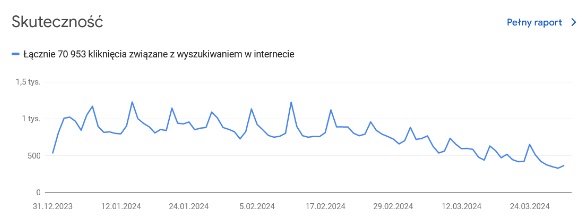
Dane z Ahrefs
To jedno z najpopularniejszych narzędzi w branży i niestety bardzo drogie. Jednak na własny użytek możesz z niego korzystać za darmo – wystarczy, że zweryfikujesz witrynę, tzn. potwierdzisz, że nią zarządzasz. Wtedy uzyskujesz dostęp do wielu danych. Ahrefs jest głównie znane jako narzędzie do analizy profilu linkowego i rzeczywiście możesz w nim monitorować, jakie odnośniki pozyskuje dla Ciebie agencja (ale nie wszystkie). Jedna z funkcji wyświetla odnośniki zdobyte, np. w ciągu ostatnich 30 dni. Jednak obecnie Ahrefs to już nie tylko linki, ale również wiele innych opcji. Dowiesz się, jak zmienia się widoczność witryny w wynikach wyszukiwania. Możesz monitorować, jakie błędy występują w serwisie. Zdecydowanie warto od czasu do czasu zaglądać do Ahrefs – dostarcza mnóstwo danych.
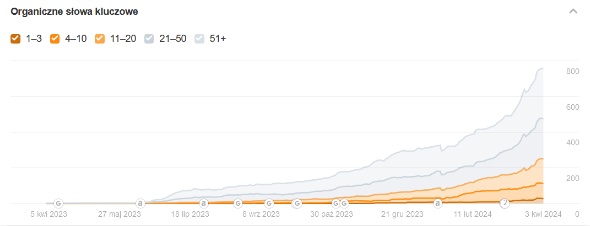
Źródło: https://app.ahrefs.com/
Analiza widoczności w Semstorm
To polskie, popularne narzędzie, które umożliwia sprawdzenie, jaka jest widoczność witryny w wynikach wyszukiwania Google. Jest płatne, ale podstawowe dane możesz sprawdzić w ramach darmowego konta. Ustalisz w ten sposób, jaki jest trend w przypadku Twojej witryny. Czy jej widoczność rośnie, czy jednak wprost przeciwnie – maleje? Pamiętaj, że rzadko witryna wyłącznie stale ją poprawia. Zdarzają się różne okresy, a widoczność może się obniżyć z różnych powodów, choćby na skutek aktualizacji algorytmu Google. Wystarczy, jeśli sprawdzisz swoją stronę w tym narzędziu raz czy dwa razy na miesiąc.

Źródło: https://app.semstorm.com/
Google Analytisc
Ten najpopularniejszy system analityczny dostarcza informacji dotyczących odwiedzin w witrynie. Dowiesz się, ile ruchu pochodzi z wyników wyszukiwania. Sprawdzisz, ile czasu użytkownicy średnio przebywają na poszczególnych podstronach. Narzędzie pomoże Ci wysnuć cenne wnioski np. które URL-e wymagają przebudowy, gdyż użytkownicy bardzo szybko opuszczają stronę – nie sprawdzają szczegółów oferty. Poza tym Google Analytics umożliwia mierzenie konwersji. Dzięki temu ocenisz, czy ruch pozyskiwany z Google realizuje zakładane cele, np. prowadzi do zamówienia produktów czy też do skorzystania z formularza kontaktowego.

Źródło: https://analytics.google.com
Możesz również korzystać z wielu innych narzędzi SEO. Pamiętaj jednak, że w pozycjonowaniu ogromne znaczenie ma czas. Efekty działań w dużej mierze zależą od branży i stanu serwisu. Warto ustalić z agencją SEO cele do realizacji na dany okres, aby wiedzieć, czego realnie możesz się spodziewać.
Pozycjonowanie sklepów internetowych
Bez względu na tematykę strony czy rodzaj prowadzonej działalności SEO obejmuje bardzo podobne kroki. Różnice mogą wynikać ze stanu serwisu, tzn. jak wielu zmian optymalizacyjnych wymaga dana witryna, ale nie tylko. Jeśli chcesz pozycjonować małą stronę firmową, będzie ona prawdopodobnie wymagać dużo mniej pracy i mniejszego budżetu niż sklep internetowy z dużą liczbą produktów. W jego przypadku ogromne znaczenie ma rodzaj oprogramowania, z którego korzysta witryna. Wszyscy twórcy popularnych systemów CMS inwestują w optymalizację, ale niestety nie jest tak, że rozwiązania są dopracowane. Wymagają mniej lub więcej dostosowania do wymagań Google. Zdarza się, że podstawowa wersja systemu nie zapewnia nawet podstawowych funkcji, które są istotne z punktu widzenia SEO. Dlatego sklep może wymagać diametralnych zmian. Jakie oprogramowanie jest najczęściej wykorzystywane w polskim e-commerce? Prezentuje to poniższa grafika.

Źródło: https://trends.builtwith.com/shop/country/Poland
Zdecydowanym liderem w Polsce jest WooCommerce. Kolejne pozycje zajmują: PrestaShop, Shoper, Wix Stores, Shopify i IdoSell. Co warto wiedzieć o poszczególnych skryptach? Czy to trafione rozwiązania, jeśli chodzi o SEO?
Pozycjonowanie sklepu WooCommerce
WooCommerce to plugin do najpopularniejszego systemu CMS, czyli WordPressa. Jeśli prowadzisz witrynę opartą na WP i chcesz dodać do niej sklep, wystarczy, że skorzystasz z tej wtyczki, a następnie ją skonfigurujesz. System nie jest idealny pod względem SEO, natomiast znajdziesz wiele bezpłatnych pluginów, dzięki którym zoptymalizujesz witrynę. Wtyczki takie jak Yoast SEO czy All in One SEO dostępne są w wersji odpłatnej, ale duże możliwości zapewniają już nawet w ramach darmowego wariantu. Jeśli będziesz potrzebować rozwiązania innych problemów związanych z SEO, również prawdopodobnie bez problemów znajdziesz odpowiednie.
Pozycjonowanie sklepu PrestaShop
Nie tak dawno ten system był najpopularniejszym w Polsce, jeśli chodzi o oprogramowanie w e-commerce. Obecnie traci na zainteresowaniu, ale w dalszym ciągu internauci z naszego kraju chętnie po niego sięgają. Ten system nie jest tak dobrze zoptymalizowany pod SEO jak WooCommerce, natomiast również zapewnia mnóstwo pluginów, z tym że większość solidnych rozwiązań jest płatna. Natomiast znajdziesz dodatki, dzięki którym bez problemów wprowadzisz niezbędne rozwiązania m.in. dodasz unikatowe meta dane, wygenerujesz mapę strony, przyjazne linki i nie tylko.
Pozycjonowanie sklepu Shoper
Oprogramowanie Shoper cieszy się coraz większym zainteresowaniem. Założenie sklepu opartego na tym systemie nie wymaga specjalistycznej wiedzy, a poza tym zapewnia on mnóstwo rozwiązań, dzięki którym dostosujesz witrynę do wymagań algorytmu Google. Po zalogowaniu się do panelu administracyjnego możesz m.in. dodawać indywidualne meta tagi dla poszczególnych podstron, edytować plik robots.txt, dodać mapę strony, atrybut alt do zdjęć, zarządzać przekierowaniami.
Pozycjonowanie sklepu Wix
Wix jest lubiany przez prowadzących sklepy WWW za prostotę ich zakładania. Jeśli chodzi o optymalizację pod SEO, zapewnia funkcje, dzięki którym bez problemów zoptymalizujesz witrynę. Edytor umożliwia ustalenie unikatowych meta tagów dla każdej z podstron. Możesz dodawać atrybuty alt do zdjęć. Wix przygotowało również przewodnik SEO Wizard, który ułatwia optymalizację witryny pod SEO. Ten system nie jest idealnym rozwiązaniem, jeśli chodzi o optymalizację pod wymagania Google, ale ma inne zalety m.in. dużo opcji personalizacji.
Pozycjonowanie sklepu Shopify
Kolejne oprogramowanie, dzięki któremu możesz łatwo założyć sklep. Zapewnia wiele funkcji, które mają duże znaczenie dla SEO. Możesz edytować plik robots.txt, aby określić, które zasoby są dostępne dla poszczególnych robotów. System generuje mapę strony, jaką musisz tylko zgłosić w Google Search Console. Shopify umożliwia dodawanie unikatowych meta danych, tagu alt dla zdjęć. System zapewnia wszystkie niezbędne rozwiązania, których możesz potrzebować, aby zoptymalizować witrynę.
Pozycjonowanie sklepu IdoSell
IdoSell to system, który nie powinien sprawić większych kłopotów pod względem optymalizacji. Bez problemów dodasz unikatowe meta dane. Dla poszczególnych stron kategorii i podkategorii łatwo wprowadzisz ich opisy. Dodasz w treściach nagłówki H1-H6, bez komplikacji dodasz również dane strukturalne, dzięki którym wynik wyszukiwania z Twojej strony może być wzbogacony o dodatkowe elementy, np. gwiazdki, cenę produktu czy informację o stanie magazynowym.
Pozycjonowanie lokalne – na jakich działaniach się skupić?
Kierujesz ofertę do mieszkańców danego miasta, powiatu czy gminy? Dzięki pozycjonowaniu lokalnemu możesz dotrzeć do zdecydowanej większości potencjalnych odbiorców. 46% wyszukiwań w Google pochodzi od użytkowników, którzy szukają właśnie lokalnych firm. Jeśli klienci potrzebują pilnie skorzystać z jakiejś usługi, np. holowania, prawdopodobnie skontaktują się z firmą, której strona zajmuje pierwsze miejsce w wynikach wyszukiwania.
Jak wspominaliśmy, Twoja oferta może być widoczna na więcej niż jednej pozycji w wynikach wyszukiwania. Wszystko dzięki wypozycjonowaniu wizytówki Google Moja Firma i strony internetowej. W obu przypadkach musisz wykonać inne działania, aby osiągnąć oczekiwany efekt. Jakie?
Pozycjonowanie Profilu Firmy w Google
W pierwszym kroku musisz najpierw założyć profil. Jest bezpłatny. Wystarczy, że wejdziesz na stronę google.com/intl/pl_pl/business/ i podasz wymagane dane. Następnie musisz przejść przez weryfikację. Dopiero po tym kroku Twoja wizytówka będzie się wyświetlać w wynikach wyszukiwania. Klienci mogą na nią trafić w standardowych rezultatach i przez Google Maps.
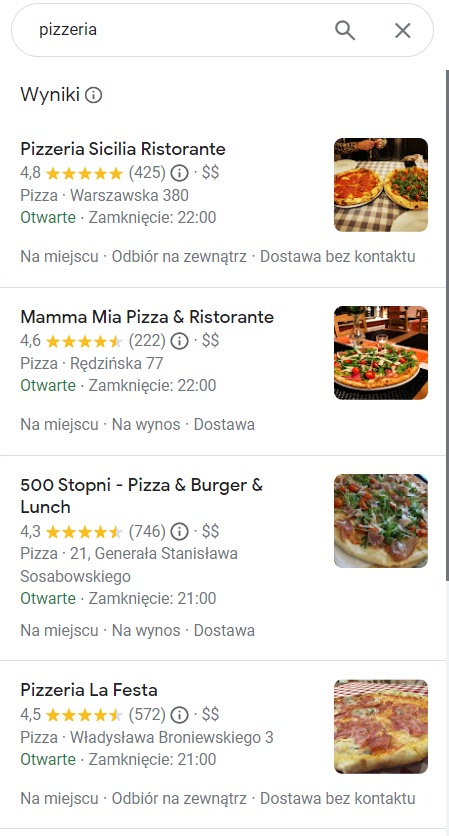
Widoczność Profilu Firmy w Google zależy od wielu czynników. Oto istotne elementy, od których zależą pozycje zajmowane przez Twoją wizytówkę na słowa kluczowe:
- Nazwa firmy – nie jest to miejsce na upychanie słów kluczowych. Jeśli będzie się składać wyłącznie z nich, profil zostanie zablokowany. Poza tym w takim przypadku internauta nie ma pojęcia, z jaką marką ma do czynienia. Optymalnym rozwiązaniem jest połączenia istotnego słowa kluczowego z nazwą marki, ale naturalnie, np. Skup Aut Top-Auto.
- Opis firmy – masz do wykorzystania 750 zzs, z których największe znaczenie ma pierwszych 250 zzs. To w tej częściej spróbuj naturalnie umieścić najważniejsze dla Twojej witryny słowa kluczowe.
- Wybierz odpowiednią kategorię – sprawdź wyniki wyszukiwania na najważniejszą dla Ciebie frazę i ustal, do jakich kategorii są przypisane wizytówki, które zajmują najwyższe pozycje. Wybierz dominującą. Tę nazwę znajdziesz na liście wyników wyszukiwania Google Maps pod gwiazdkami.
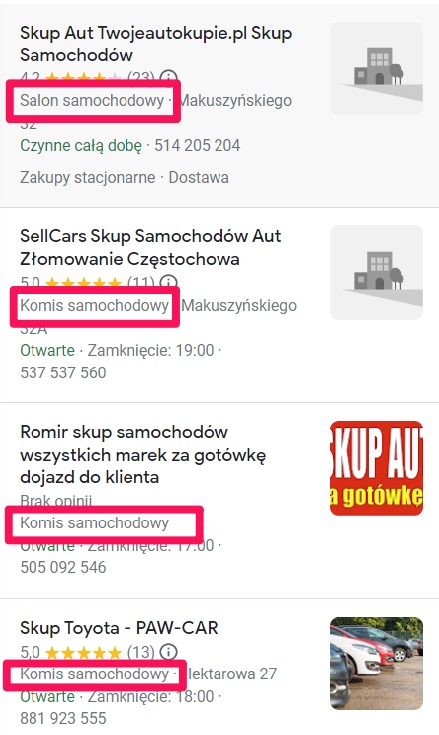
- Wypełnij wizytówkę – dodaj wszystkie dane, które odnoszą się do Twojej działalności i je aktualizuj. Szczególnie ważne są godziny otwarcia. Nie powinno być tak, że według danych na profilu firma jest otwarta, a na miejscu okazuje się, że jednak nie. Zwróć uwagę, czy podane godziny są prawidłowe. Google wyświetla na wyższych pozycjach te firmy, które aktualnie są otwarte. To nie oznacza, że masz ustawić dostępność przez całą dobę. Podaj godziny zgodne z prawdą.
- Pozyskiwanie opinii – zachęcaj klientów do ich wystawiania. Idealnie, jeśli pojawiają się regularnie, składają się z kilku zdań i zawierają słowa kluczowe. Jeśli ktoś wystawi opinię, koniecznie na nią odpowiedź – nie ma znaczenia, czy jest pozytywna, czy negatywna. Nie dodawaj za każdym razem takiej samej odpowiedzi. Może być krótka, ale najlepiej, jeśli jest unikatowa.
- Umieść na stronie mapę Google ze wskazaniem siedziby – to przydatne dla użytkownika, ale też ważne dla algorytmu wyszukiwarki, gdyż powiązuje daną witrynę z Profilem Firmy w Google.
- Pozyskiwanie wizytówek NAP – to skrótowiec od Name, Address, Phone Number, wizytówka firmy w internecie. W praktyce przybiera postać wpisów w katalogach, które zawierają nazwę marki, jej opis, dane kontaktowe, a przeważnie również adres strony. Jeśli zdobywasz takie profile, pamiętaj o spójności. Używaj takich samych danych jak w wizytówce czy na stronie.
- Aktywnie prowadź profil – publikuj zdjęcia, dodawaj wpisy. Może to być dodatkowy kanał komunikacji z klientami, na którym informujesz o promocjach. Dodawaj produkty i usługi. W wielu przypadkach od zawartości profilu zależy, czy internauta zadzwoni lub odwiedzi, np. Twoją restaurację.
Poza tym musisz się uzbroić w cierpliwość. Jeśli będziesz dbać o wizytówkę, masz duże szanse na uzyskanie oczekiwanej widoczności.
Pozycjonowanie strony firmy lokalnej w Google
Osiągnięcie wysokich pozycji w wynikach lokalnych przez stronę WWW wymaga podjęcia innych działań. Są one podobne do tych, które należy prowadzić w przypadku innych stron, ale występują pod tym względem pewne różnicę. Jeśli chcesz osiągnąć widoczność na frazy lokalne, podejmij następujące kroki:
- Ustal słowa kluczowe – przeanalizuj, jakie frazy wyszukują internauci, którzy szukają tego, co oferujesz. Skorzystaj z kilku różnych narzędzi i na tej podstawie wybierz najlepsze słowa kluczowe;
- Zoptymalizuj witrynę pod słowa kluczowe – kiedy masz już listę fraz, umieść je w contencie na stronie. Najważniejsza fraza kluczowa powinna się znaleźć w tytule SEO strony (tag title), tytule podstrony (nagłówek H1) i pozostałych nagłówkach, o ile tam pasuje (H2-H6), a także naturalnie w pozostałym contencie. Poza tym skorzystaj z tej frazy przy nazwach plików graficznych i w ich opisie (tagu alt).
- Przygotuj landing page dla poszczególnych miast, dzielnic czy gmin – jeśli ofertę kierujesz do mieszkańców różnych miast czy wybranych dzielnic, opracuj dla każdej unikatową treść i zoptymalizuj ją pod słowa kluczowe związane z daną lokalizacją.
- Twórz content na bloga – dodawaj porady dotyczące danego produktu, jego użytkowania, możliwości oraz sposobu radzenia sobie z usterkami. W treściach dodawaj linki wewnętrzne do landing page opisujące oferowane usługi. Poza tym wykorzystaj content do umieszczenia zdjęć produktu oraz tutoriale pokazujące realizację usługi, aby zachęcić internautów do kliknięcia;
- Optymalizacja techniczna – obejmuje wiele działań, takich jak usunięcie błędów związanych z indeksowaniem, dodanie szyfrowanego połączenia (SSL), zarządzanie przekierowaniami, dodanie przyjaznych linków i nie tylko.
- Wprowadź linkowanie wewnętrzne – każda istotna podstron w serwisie powinna być podlinkowana z przynajmniej kilku innych podstron.
- Pozyskuj linki prowadzące do witryny – postaw przede wszystkim na odnośniki powiązane tematycznie, np. z innych witryn lokalnych (serwisów informacyjnych, for czy katalogów regionalnych). Poza tym sięgaj po odnośniki na stronach związanych z Twoją branżą. Takie podejście powoduje, że link może nie tylko przyczynić się do poprawy widoczności strony w Google, ale zwiększyć też ruch organiczny.
To tylko część działań, które trzeba podjąć, aby zwiększać widoczność witryny w lokalnych wynikach wyszukiwania. Poza tym stale rozwijaj stronę, dbaj o szybkość działania oraz responsywność.
On-site SEO – jakie obejmuje działania?
Wspominaliśmy już, że SEO dzieli się na on-site, czyli działania w obrębie strony internetowej i off-site, czyli kroki poza witryną tzn. nie musisz mieć dostępu do panelu administracyjnego witryny czy jej kody, aby je prowadzić. Poniższa grafika pokazuje, jakie działania wykonuje się w obrębie tych grup. Przyjrzyjmy się bliżej, jakie kroki podejmuje się w obu przypadkach.

Źródło: https://www.semrush.com/blog/on-page-seo/
Jeśli chodzi o on-site SEO, to ilość pracy do wykonania zależy głównie od stanu Twojego serwisu.
Optymalizacja meta danych
Ten krok obejmuje tytuł SEO strony, czyli tag title, a także opis – tag description. Kluczowym elementem jest tytuł, który ma duży wpływ na widoczność danego contentu w Google. Możesz się spotkać z informacjami, że powinien zajmować 60 czy 70 znaków ze spacjami. W praktyce ma to być nie więcej niż 600 px. Jeśli będziesz optymalizować treść w takich narzędziach jak np. Contadu, to przy tworzeniu tytułu od razu dowiesz się, czy spełnia wymagania pod tym względem. Najważniejsze słowo kluczowe powinno się znaleźć na początku. Nie upychaj w nim fraz. Jeśli zrobisz inaczej, Google może zignorować Twoją propozycję i wyświetlić w wynikach wyszukiwania tytuł, który według algorytmu lepiej pasuje do zapytania i zawartości strony. Według analizy przeprowadzonej przez Ahrefs, Google zmienia tytuły ponad 1/3 analizowanych stron.
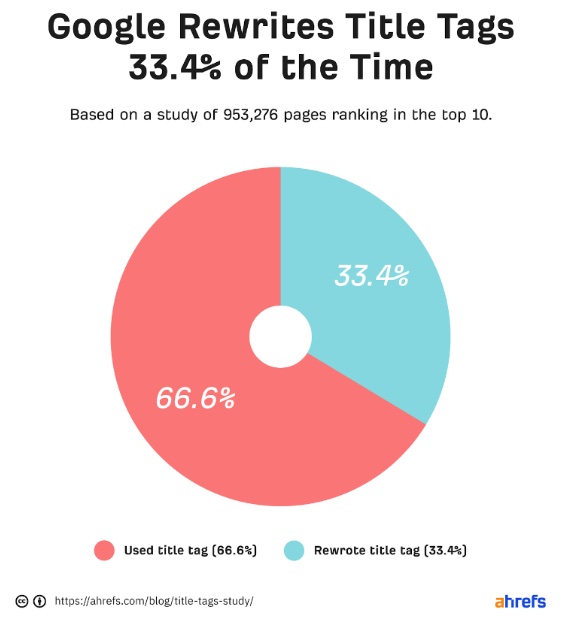
Źródło: https://ahrefs.com/blog/title-tags-study/
Jeśli chodzi o meta opis, czyli description, nie jest to element, który ma wpływ na widoczność strony, natomiast to treść, która może się wyświetlać w wynikach wyszukiwania, więc ma wpływ na CTR (współczynnik klikalności). Najlepiej dodaj tam najważniejsze słowo kluczowe i wezwanie do działania, np. kliknij i dowiedz się, jak…. Według Ahrefs Google używa innych meta opisów niż dodane przez webmastera w 62,78% przypadków.
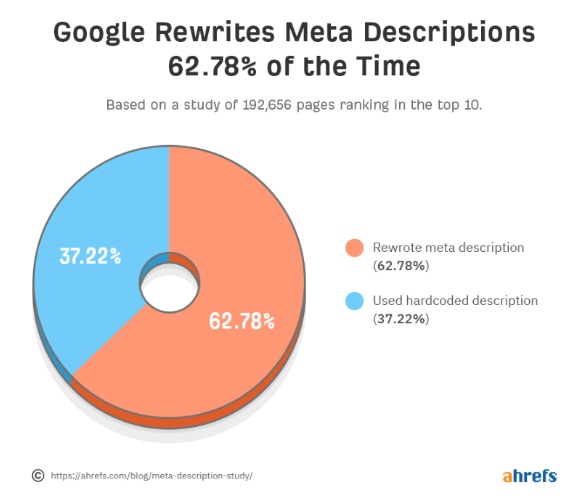
Źródło: https://ahrefs.com/blog/meta-description-study/
Odpowiedni rozkład nagłówków
Dzięki ich odpowiedniemu zastosowaniu tekst jest atrakcyjniejszy wizualnie, ale również lepiej widoczny w wynikach wyszukiwania Google. W contencie wykorzystuje się nagłówki od H1 do H6. Przy czym najważniejszym jest H1. Przeważnie to tytuł danej podstrony, np. nazwa kategorii, produktu lub tytuł wpisu blogowego. Ten nagłówek powinien zawierać najważniejsze słowo kluczowe. Nie musi być krótki – może się składać nawet z 2-3 zdań.
W treściach pozostałych nagłówków umieść istotne słowa kluczowe – te, na które chcesz pozycjonować dany content. Jednocześnie pamiętaj, że nie chodzi o upychanie fraz. Tworząc treści, myśl o odbiorcy. Nie buduj contentu wyłącznie pod algorytm Google. Pod każdym nagłówkiem odpowiadaj na postawione pytanie czy problem.
Optymalizacja zdjęć
Fotografie z jednej strony powinny być wysokiej jakości, ale z drugiej nie mogą zajmować dużej powierzchni, aby nie opóźniały ładowania witryny. Dlatego, każda grafika, która trafia na serwer, powinien być zoptymalizowana pod tym kątem. W przypadku popularnych systemów CMS znajdziesz gotowe pluginy, które automatycznie zmieniają wielkość pliku. Zanim jednak wyślesz grafikę na serwer, pamiętaj o odpowiednim nazewnictwie. Niech nazwa składa się z najważniejszego słowa kluczowego dla danej treści, np. czerwona-sukienka-diana.jpg. Nie używaj wielkich liter, a między słowami umieść znak łącznika – nie podkreślnik.
Kolejnym ważnym działaniem w przypadku zdjęć jest dodawanie tagu alt, znanego również jako atrybut alt i opis alternatywny. Popularne systemy CMS dają możliwość bezproblemowego dodania tego tagu. Alt powinien zawierać opis, co znajduje się na stronie. W tym przypadku również użyj słowa kluczowego, ale nie wyłącznie. Po co to robić? Dzięki dodaniu tej treści zwiększasz szansę na widoczność strony w Google Grafika, co w wielu branżach, np. modowej, jest kluczowe. Pamiętaj, że nawet takie detale są uznawane za czynniki rankingowe.
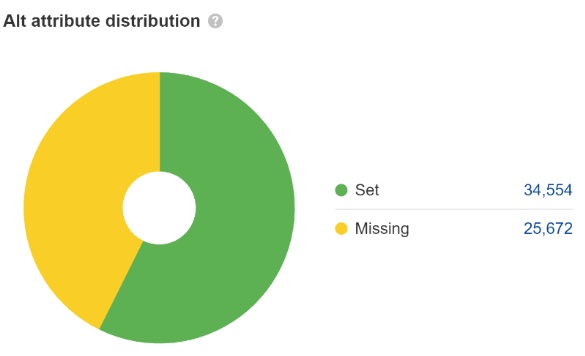
Źródło: https://ahrefs.com/blog/site-audit-study/
Linkowanie wewnętrzne
Odgrywa ono bardzo istotną rolę nie tylko ze względu na optymalizację pod SEO. Dzięki linkom prowadzącym do poszczególnych podstron użytkownik może docierać tam, gdzie chcesz, aby trafiał. Dodając odnośniki na podstronach, kierujesz jego ścieżką. Załóżmy, że dociera na Twoją stronę po wyszukaniu wpisu typu “jak kupić dany produkt?”. Z contentu dowiaduje się, na co zwrócić uwagę i jak korzystać z danego rozwiązania, a następnie od razu przechodzi na podstronę, na której może złożyć zamówienie.
Na linkowanie wewnętrzne składa się wiele elementów. Jednym z kluczowych jest menu główne. Opracuj drzewo kategorii tak, aby internauta bez problemów znalazł to, czego szuka. Używaj nazewnictwa oczywistego, ale również korzystaj ze słów kluczowych najczęściej wyszukiwanych przez internautów.
Elementem linkowania wewnętrznego jest również menu w stopce. Zawiera zazwyczaj odnośniki do wybranych podstron w serwisie m.in. O nas, Kontakt, Polityka prywatności czy Regulamin.
Odnośniki umieszczaj również w opisach kategorii i wpisach blogowych. W przypadku sklepów zdecydowanie warto wdrożyć menu okruszkowe, które zawiera ścieżkę do danego materiału w serwisie. Oznacza to, że możesz się łatwo przenieść na stronę konkretnej kategorii. Przykładowe menu okruszkowe znajduje się na poniższej grafice:

Źródło: https://www.mediaexpert.pl/smartfony-i-zegarki_smartfony/smartfon-apple-iphone-15-pro-256gb-5g-6-1-120hz-tytan-czarny
Przyjazne linki
Chodzi tutaj o takie odnośniki, z których wynika, co możesz znaleźć na stronie. Nie składają się z ciągu przypadkowych znaków. Zerknij poniżej:
- https://www.mediaexpert.pl/smartfony-i-zegarki_smartfony/smartfon-apple-iphone-15-pro-256gb-5g-6-1-120hz-tytan-czarny – ten URL jasno wskazuje, co znajdzie internauta.
- https://www.mediaexpert.pl/HKLGHLLFGHjdwd – w tym przypadku to jest zagadką.
Przeważnie systemy CMS mają automatycznie włączone przyjazne linki. Czasami może to wymagać skorzystania z pluginu, ale wdrożenie tego rozwiązania nie powinno stanowić problemu.
Szybkość działania witryny
Strona powinna wczytywać się jak najszybciej. Każda sekunda oczekiwania zniechęca internautę do skorzystania z oferty. Znaczenie ma jednak nie tylko to, ale również wyniki wskaźników Core Web Vitals, które opisują wydajność serwisu. Rezultat zależy od wielu czynników, a strona może wymagać diametralnych zmian, aby osiągać oczekiwany efekt. Znaczenie ma również serwer, na którym się znajduje – dostępne na nim technologie. Wynik stron możesz sprawdzić na pagespeed.web.dev.

Źródło: https://pagespeed.web.dev/
Responsywność strony
Witryna powinna działać bez problemów na różnych urządzeniach bez względu na rozmiar ekranu. Jeśli tak nie jest, to może nie tylko wpływać negatywnie na widoczność w Google, ale również skutkować wysokim wskaźnikiem odrzuceń. W przypadku gdy użytkownik ma problemy z wykonywaniem podstawowych operacji na stronie, prawdopodobnie nie będzie z niej dalej korzystać. Dlatego konieczne jest nie tylko wdrożenie responsywnej strony, ale również monitorowanie, czy nie występują błędy.
Dane strukturalne
Dzięki ich zastosowaniu na stronie robot Google może łatwiej zrozumieć, co oznacza dana treść. Tzn. będzie wiedzieć, że to np. cenę, informacja o stanie magazynowym czy też ocena. Co istotne, te dane może wyświetlić w wynikach wyszukiwania, a to przyczynia się do wzrostu wskaźnika klikalności. Dodatkowe elementy zwracają uwagę internautów, dlatego zdecydowanie warto wdrożyć dane strukturalne na stronie.
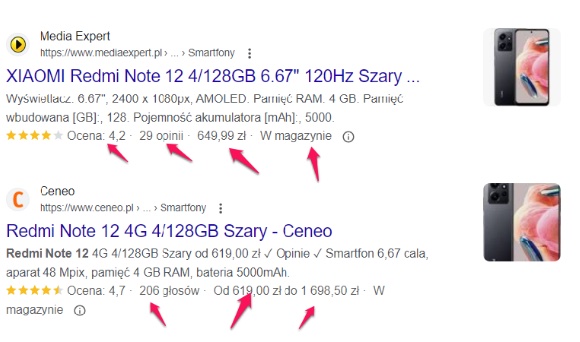
Wdrożenie szyfrowanego połączenia
Google od lat promuje bezpieczeństwo w sieci, co spowodowało dodanie nowego czynnika rankingowego w postaci szyfrowanego połączenia. W efekcie ponad 80% witryn korzysta już z certyfikatu SSL, który zresztą nie wymaga ponoszenia jakichkolwiek kosztów – chyba że wybierzesz komercyjny. Dzięki szyfrowanemu połączeniu dane wysyłane między stroną a urządzeniem użytkownika są bezpieczne – nie zostaną zmienione ani przechwycone przez internetowych oszustów. Adres strony, która korzysta z szyfrowanego połączenia, zaczyna się od https://. Wyszukiwarka Google Chrome oznacza serwisy, które nie korzystają z tego rozwiązania jako niezabezpieczone, co może negatywnie wpływać na konwersję.

Źródło: https://w3techs.com/technologies/details/ce-httpsdefault
Odpowiednie przekierowania na stronie
Dla wyszukiwarki Google adresy onet.pl i www.onet.pl są różne. Bez odpowiednich przekierowań Twoja witryna może być zindeksowana kilkukrotnie z tą samą treścią pod różnymi URL-ami, co będzie negatywnie wpływać na jej widoczność w wynikach wyszukiwania. Jednym z podstawowych kroków w optymalizacji on-site jest dodanie przekierowania 301 na jeden adres. Jeśli wdrażasz wersję witryny z https, musisz ustawić przekierowanie z http. 301 możesz również potrzebować do wyeliminowania różnych problemów związanych z indeksowaniem. Jeśli Google Search Console wskazuje na 404, to możesz przekierować na istniejące. Masz dwa podobne artykuły na stronie? W takim przypadku połącz je w jeden i ten, który ma gorszą widoczność przekieruj na ten z lepszą.
Pamiętaj również, że jeśli dodajesz przekierowanie, to z danej strony do witryny docelowej. Nie dodawaj pętli przekierowań tzn. A do B, B do C, C do D. Robot Google może się pogubić i nie zindeksować treści docelowej. Poza tym każde przekierowanie oznacza ubytek mocy SEO. W opisanym przypadku przekieruj strony A, B i C bezpośrednio na D.
Wewnętrzna duplikacja treści
Poszczególne podstrony w serwisie powinny zawierać unikatowe treści. Często jednak zdarza się, że w oczach Google tak nie jest i nawet nie zdajesz sobie z tego sprawy, a przyczyny wynikają z błędów technicznych. Być może zdarzyło Ci się dodać dwukrotnie tę samą treść. Taki przypadek jednak nie jest większym problemem – usuń jedną z nich i ustaw przekierowanie 301 na pozostawiony tekst. Jednak przyczyn wewnętrznej duplikacji jest wiele. Często problem wynika z braku przekierowania wszystkich URL-i w serwisie na wersję szyfrowaną z https://. Innym jest brak ustalonego jednego adresu, w wyniku czego Google może indeksować tę samą treść pod różnymi adresami. Przykładowym narzędziem, które ułatwia odnalezienie duplikacji w serwisie, jest Siteliner. Darmowa wersja nakłada jednak wiele ograniczeń, a poza tym kwestia duplikacji wymaga wykorzystania różnych rozwiązań do analizy.
Off-site SEO – jakie obejmuje działania?
Działań realizowanych poza witryną jest mniej, ale nie możesz ich pominąć, jeśli chcesz rozwijać widoczność witryny w wynikach Google. Różni specjaliści inaczej interpretują off-site SEO. Niektórzy zaliczają do tych działań wyłącznie linki. Tymczasem można wyodrębnić ich więcej.
Link building
Chodzi o pozyskiwanie odnośników zewnętrznych, które prowadzą do pozycjonowanej witryny. Bez inwestycji w wysokiej jakości odnośniki witryna nie ma szans na zajmowanie wysokich pozycji na konkurencyjne frazy. Link building to skomplikowane zagadnienie, które wymaga zwrócenia uwagi na wiele elementów. Nie jest tak, że każdy pozyskany odnośnik pozytywnie wpłynie na widoczność. Co więcej – możliwe, że w przypadku jednej strony efekt będzie pozytywny, a innej negatywny lub żaden. Znaczenie ma aktualny profil linkowy Twojej witryny, rozkład anchorów i nie tylko.
Jeśli chodzi o źródła pozyskiwania odnośników, to im większe zróżnicowanie, tym lepiej. Możesz sięgnąć po odnośniki z różnego typu witryn: serwisów informacyjnych, katalogów stron, portali, serwisów społecznościowych, for, komentarzy pod artykułami i nie tylko. Warto stawiać na tematyczne odnośniki, z witryn branżowych, gdyż to może przełożyć się nie tylko na moc SEO, ale również odwiedziny na stronie i pozyskanie klientów. Czy jednak na pewno ich większa liczba przekłada się na poprawę widoczności? Zdecydowanie tak. Badanie przeprowadzone przez Ahrefs pokazuje, że większa liczba odnośników przekłada się na widoczność na więcej fraz kluczowych.

Źródło: https://ahrefs.com/blog/search-traffic-study/
Content marketing
To działania, które możesz prowadzisz zarówno w obrębie strony, jak i poza nią. Polegają one na tworzeniu takiego contentu, który nie tylko zainteresuje odbiorców, ale również ich zaktywizuje. Oznacza to, że udostępnią daną treść w serwisie społecznościowym, dodadzą do niej link na swoim blogu, forum czy w komentarzu. Efekty content marketingu mogą przyczynić się do budowania profilu linkowego witryny – pozyskania wartościowych odnośników, których nie da się zdobyć z innych źródeł, nawet odpłatnie. Pamiętaj jednak, że polega to nie tylko na tworzeniu treści. Contentem może być grafika, wideo, muzyka, infografika i inne materiały. Często możesz się spotkać z interpretacją, że content marketing to po prostu teksty sponsorowane. Mogę one wywołać taki efekt, o ile są wartościowe, ale nie zalicza się do nich wyłącznie artykułów czy poradników. Badanie wykonane przez Aira pokazało, że content marketing jest obecnie najpopularniejszym sposobem pozyskiwania linków przez specjalistów.

Social media
Dyskusja na temat wpływu działalności w serwisach społecznościowych na widoczność witryny w wynikach wyszukiwania Google trwa od lat. Nie ma to bezpośredniego wpływu, ale pośredni zdecydowanie tak. Z drugiej strony, jeśli prowadzisz social media, możesz umieścić w nich linki prowadzące do Twojej witryny. Będą to zapewne odnośniki nofollow, ale mimo wszystko warto je mieć.
Poprzez serwisy społecznościowe możesz dotrzeć ze swoim materiałem do bardzo dużej liczby odbiorców. Być może wśród nich są takie osoby, które go udostępnią na blogu lub w inny sposób poinformują swoich obserwatorów. Jeśli chcesz maksymalnie wykorzystać potencjał, umieść buttony w swoich materiałach na stronie, które umożliwiają łatwe udostępnienie materiałów w serwisach społecznościowych. Z analizy Authority Hacker wynika, że 61,7% ankietowanych korzystało z mediów społecznościowych przy pozyskiwaniu linków. Ta grupa uzyskała średnio o 22% więcej linków niż ci, którzy nie korzystali z mediów społecznościowych.

Źródło: https://www.authorityhacker.com/link-building-survey/
Influencer marketing
Współpraca ze znanymi osobami, które są popularne w sieci, mają wielu obserwatorów w social media i poczytne blogi może nie tylko zwiększyć znajomość Twojej marki, doprowadzić do zdobycia klientów, ale również poprawić widoczność w wynikach wyszukiwania Google. Informacja o Twojej firmie może trafić do ogromnej liczby odbiorców, co zwiększa szanse na wzmianki w sieci. Zazwyczaj domeny osób znanych mają bardzo dobrą reputację, są podlinkowane z mnóstwa cenionych serwisów, dlatego link pozyskany z takiej witryny może być cenny. Problem w tym, że przeważnie reklama za pośrednictwem influencera nie należy do tanich, dlatego wymaga to solidnej kalkulacji. Weź pod uwagę jednak nie tylko wartość linka, ale również potencjał sprzedażowy i wizerunkowy.
Jak budować profil linkowy witryny?
Link building to zagadnienie, które wymaga wiedzy i doświadczenia. W przeciwnym wypadku możesz popełniać kosztowne błędy – inwestować w odnośniki, które będą przynosić efekt odwrotny do oczekiwanego. Przy pozyskiwaniu odsyłaczy trzeba pamiętać o ważnych zasadach, rozumieć, czym się różnią odnośniki z różnych źródeł i nie tylko.
Atrybuty linków
Kiedy widzisz jakieś odnośniki na stronach, to one wyglądają identycznie. Klikasz i przekierowujesz się na inną witrynę, która może otworzyć się w tym samym lub w innym oknie przeglądarki. Tymczasem kod tego odsyłacza ukrywa ważną informację w postaci atrybutu czyli tagu rel. Może on wyglądać np. jak poniżej:
<a href=”https://www.twojastrona.pl” rel=”nofollow”>kliknij</a>
Tagi rel określają relację między stroną źródłową a docelową – możesz za ich pomocą poinformować Google o relacjach z daną witryną. Wyszukiwarka rekomenduje ich użycie, aby ułatwiać algorytmowi ocenę odnośników:
- Follow – tak naprawdę taki tag nie istnieje. Jeśli kod linka nie zawiera tagu rel, wtedy Google automatycznie interpretuje go jako follow, co oznacza, że będzie za nim podążać i przekaże stronie docelowej „moc” SEO. Często takie odnośniki nazywane są również dofollow. To właśnie te linki są najcenniejsze z punktu widzenia pozycjonowania.
- Nofollow – według Google masz używać takiego tagu rel, jeśli nie chcesz, aby robot powiązał Twoją witrynę z tą linkowaną. Zatem taki odnośnik nie powinien przekazywać mocy SEO. Praktyka jednak pokazuje, że jest inaczej.
- UGC – czyli User Generated Content. Ten tag ma zastosowanie w przypadku treści wygenerowanych przez użytkowników. Google zaleca jego używanie tam, gdzie internauci mogą dodawać na Twojej stronie linki, np. w komentarzach czy na forach. Jednocześnie podpowiada, że możesz usunąć tag w przypadku użytkowników, którzy tworzą content wysokiej jakości.
- Sponsored – Google sugeruje korzystanie z tego atrybutu w przypadku płatnych odnośników. Zatem zgodnie z zaleceniami, jeśli inwestujesz w publikacje sponsorowane z linkami, to powinny one mieć dodany właśnie rel=”sponsored”.
Atrybuty linków mają duże znaczenie. Nie warto posiadać wyłącznie odnośników follow – lepiej, aby profil był urozmaicony o różne odsyłacze. Nie ma sensu tutaj podawanie udziału procentowego – po prostu staraj się, by profil wyglądał w miarę naturalnie, obejmował linki z różnymi atrybutami. Jedyne, które możesz sobie odpuścić, to tag sponsored. Moc takich odnośników jest zerowa. A co z nofollow i UGC? Takie odsyłacze mogą pozytywnie wpłynąć na widoczność.
Anchory
Anchor to po prostu treść linka, tzw. kotwic w tekście, która często wyróżniona jest kolorem, pogrubieniem lub podkreśleniem. Kliknięcie tego anchora powoduje przeniesienie na stronę WWW, do której prowadzi odnośnik. Odgrywają one bardzo istotną rolę w pozycjonowaniu. Linki, których anchor jest taki jak pozycjonowana fraza, mogą mieć największy wpływ na wzrost pozycji (w dużym uproszczeniu). Kiedyś rzeczywiście wszystkie mogły mieć takie anchory, nazywane exact match. Jednak aktualizacja Pingwin, którą Google przeprowadziło w 2014 roku, wywróciła sytuację do góry nogami. Obecnie ogromne znaczenie ma zróżnicowanie anchorów. Możesz się spotkać z różnymi zaleceniami odnośnie do tego, ile powinien wynosić odsetek linków exact match – przeważnie od 5 do 30%. W praktyce warto wyciągać wnioski co do tego na podstawie analizy konkurencji, tzn. jak to wygląda w przypadku witryn, które zajmują najwyższe pozycje w wynikach wyszukiwania.
Co istotne, anchory exact match powinny być zróżnicowane – warto używać co najmniej kilku w odniesieniu do danej podstrony. Natomiast zawsze powinny dominować linki w naturalnej formie, czyli w postaci adresu URL. Do tego odnośniki brandowe, ewentualnie takie, które mogą być używane przez internautów, np. kliknij tutaj, sprawdź to.
Źródła linków
Jeśli budujesz profil odnośników, nie zdobywaj wyłącznie linków jednego typu, np. z publikacji sponsorowanych. Lepiej je różnicować i stawiać na kreatywność. Podstawowe źródła odsyłaczy to na pewno fora, komentarze, wpisy gościnne, katalogi stron i publikacje sponsorowane. Natomiast możesz pozyskiwać linki na wiele różnych sposobów. Oto przykładowe propozycje:
- źródło danych we wpisie w Wikipedii;
- sponsoring danej imprezy, patronat medialny;
- organizacja konkursu;
- profile w social media;
- informacje prasowe;
- ogłoszenia.
To tylko przykłady. Im większa kreatywność, tym lepiej, ale najważniejsze, aby odnośnik znalazł się na wysokiej jakości stronie.
Na jakich stronach pozyskiwać linki?
Wybór serwisów, na których umieścisz odnośniki wymaga poświęcenia wiele uwagi. Znaczenie ma mnóstwo czynników. Jeśli nie zwrócisz na nie uwagi, możesz zainwestować dużą kwotę w odsyłacz, który nie przyniesie żadnych korzyści Twojemu serwisowi. Jeśli korzystasz z darmowego sposobu pozyskania linka, lepiej umieść odnośnik w formie adresu URL, gdyż to najbezpieczniejsze rozwiązanie. Natomiast, kiedy inwestujesz w odsyłacz, warto bliżej przyjrzeć się stronie, na której ma się znaleźć. Na co zwrócić uwagę w analizie, a co nie powinno mieć znaczenia?
Wskaźniki jakości linków
Popularne narzędzia do analizy profilu odnośników, takie jak Ahrefs czy Majestic SEO, mają własne wskaźniki za pomocą których oceniają jakość odsyłaczy. W przypadku Ahrefs to Domain Rating, a w Majestic – Trust Flow. Teoretycznie, im są wyższe, tym lepiej. Rzeczywiście warto brać je pod uwagę, gdyż wysoki wynik oznacza, że według kryteriów branych pod uwagę przez dany serwis, masz do czynienia z domeną o bardzo dobrych parametrach pod względem SEO. To jednak nie sugeruje, że w każdym przypadku będzie to prawda. Jeśli wskaźnik jest wysoki, sprawdź profil linkowy danej witryny. W przypadku gdy zobaczysz tam zupełnie niepowiązane tematycznie odnośniki z zagranicznych witryn, bardzo prawdopodobne, że doszło do manipulacji. Właściciel witryny sztucznie podbił wynik, aby zwrócić uwagę kupujących odnośniki. W takich przypadkach zazwyczaj wskaźniki nawet w kilka tygodni zdecydowanie spadną. Lepiej unikać takich witryn.
Jaki będzie atrybut linka?
Jeśli chcesz kupić odnośnik w danej witrynie, dopytaj, jaki będzie atrybut rel. Zdarza się, że serwisy proponują inne stawki w przypadku follow, nofollow i sponsored. Niektóre witryny w ogóle nie publikują odnośników dofollow. Upewnij się, jak to wygląda w danym przypadku. Jeśli strona proponuje wyłącznie odnośniki z tagiem sponsored, lepiej zrezygnuj, gdyż z punktu widzenia SEO to bezwartościowy odsyłacz. Najlepiej, gdy będzie to follow. Jeśli jednak to domena o bardzo dobrych parametrach, weź pod uwagę także nofollow.
Gdzie zostanie dodana publikacja?
Jeśli artykuł sponsorowany trafia na stronę główną wartościowego serwisu, może być zindeksowany przez Google nawet w ciągu kilku minut. Indeksacja to warunek konieczny, aby pozyskany odnośnik wpływał na widoczność Twojej strony. Często zdarza się, że witryny proponują różne opcje dodania odnośnika, np. na określony czas na stronie głównej albo wyłącznie w danej kategorii. Jeśli trafi do podkategorii, to możliwe, że nie zindeksuje się samoczynnie – będzie wymagać dodania zewnętrznych odnośników.
Zdarza się, że witryny mają specjalne kategorie, które w ogóle nie są podlinkowane z menu głównego i tam umieszczają publikacje. Siła takiego odnośnika może być bardzo niska. Dlatego zawsze sprawdzaj, gdzie będzie się znajdować w serwisie. Idealnie, jeśli witryna umożliwia wewnętrzne podlinkowanie artykułu z innych podstron. Wtedy odnośnik jest bardziej wartościowy.
Czy witryna składa się wyłącznie z artykułów sponsorowanych?
Niektóre witryny powstają wyłącznie po to, aby zarabiać dla właściciela na publikacjach. Problem w tym, że zazwyczaj Google z czasem dostrzega takie serwisy, obniża ich widoczność, a pozyskane odnośniki stają się bezwartościowe. Publikacje sponsorowane powinny stanowić jedynie pewien odsetek wszystkich treści. Pamiętaj, że właściciel takiej strony będzie ją prawdopodobnie prowadzić do momentu uzyskiwania przychodów. Kiedy zainteresowanie będzie zerowe, może nie przedłużyć domeny. Lepiej publikować na stronach, które istnieją od dawna i są regularnie aktualizowane. W takim przypadku prawdopodobnie link pozostanie wartościowy nawet po dłuższym okresie.
Jak długo będzie widoczna publikacja?
Zdecydowanie bierz pod uwagę te oferty, które obejmują dodanie artykułu dożywotnio, tzn. do kiedy strona będzie działać. W wielu przypadkach propozycja wiąże się jedynie z publikacją na 12 miesięcy, a później artykuł znika. Jeśli opłata za przedłużenie jest niewielka, a witryna wartościowa, warto dopłacać. W przypadku gdy strona daje do wyboru publikację na rok lub na dłuższy okres, zdecydowanie lepiej wybrać tę drugą. Prawdopodobnie w przeliczeniu na lata wypadnie zdecydowanie korzystniej.
Czy na podstronach serwisu pojawia się spam?
Jeśli pozyskujesz link, zwróć uwagę, czy na tej samej podstronie mogą go również łatwo dodać inni. Załóżmy, że kupujesz publikację, pod którą użytkownicy bez żadnej moderacji dodają komentarze – w dodatku z linkami dofollow. To oznacza, że takich odsyłaczy mogą pojawić się tam setki i pozyskany odnośnik nie będzie mieć żadnej wartości, a nawet wprost przeciwnie – obniży ją.
Widoczność strony w wynikach wyszukiwania Google
Witryna, na której chcesz pozyskać odnośnik, powinna być solidnie podlinkowana, ale to nie wszystko. Sprawdź jej widoczność w wynikach wyszukiwania Google. Możesz to zrobić bezpłatnie, np. w narzędziu Semstorm. Jeśli ta widoczność od dawna regularnie maleje, jak na poniższym wykresie, istnieje ryzyko, że pozyskany link będzie bezwartościowy. A co z serwisami, które w ogóle nie są widoczne w Google? Taki link może pozytywnie wpłynąć na widoczność Twojej strony, ale nie musi. Bezpieczniej wybierać strony, które mają zadowalającą widoczność.

Źródło: https://app.semstorm.com/
Podlinkowanie danej podstrony
Ma to ogromne znaczenie, jeśli kupujesz linki na istniejących podstronach. Takie odnośniki mogą być bardzo wartościowe – szczególnie jeśli wybierzesz URL, który ma dobrą widoczność w Google, jest podlinkowany wewnętrznie i zewnętrznie. Zakup tego odsyłacza może być dużo lepszą decyzją niż nowa publikacja. Przy wyborze podstrony, na której chcesz kupić link, warto posłużyć się narzędziami SEO, aby wybrać najlepiej podlinkowane podstrony o największej widoczności. Pomogą przy tym m.in. Ahrefs, Screaming Frog, Senuto czy Semstorm.
Powiązanie tematyczne
Czy link z witryny, która podejmuje taką samą tematykę co Twój serwis, jest bardziej wartościowy? Dyskusje na ten temat trwają od lat. Radzimy podejść do tego w inny sposób – powiązanie tematyczne powoduje, że pozyskany odnośnik może przynieść nie tylko moc SEO, ale także przełożyć się na kliknięcia linka i pozyskanie klientów. Trudno jednak opierać budowanie profilu odnośników wyłącznie na witrynach powiązanych tematycznie, ale zdecydowanie warto, aby było ich jak najwięcej wśród linków prowadzących do strony.
Cena za link
Nie ma problemów z pozyskaniem odnośników na najpopularniejszych stronach w Polsce. Kłopot tkwi jednak w tym, że jego zakup może być zupełnie nieopłacalny. Oczywiście, każdy przypadek wymaga indywidualnego podejścia, ale zazwyczaj zakup odnośnika za kilkanaście tysięcy złotych nie będzie korzystny. W tym budżecie możesz kupić nawet kilkadziesiąt wartościowych linków i uzyskać zdecydowanie lepszy efekt niż tym jednym linkiem. Tylko w wybranych przypadkach ma sens zainwestowanie bardzo dużych pieniędzy w jeden odnośnik.
Czy na podstawie tych wszystkich informacji możesz już kupować odnośniki, mając pewność, że osiągniesz efekt? Niestety, ale żadna weryfikacja nie daje 100% gwarancji. Jako agencja SEO regularnie sprawdzamy skuteczność linków, z których korzystamy w ramach kampanii realizowanych dla klientów, dlatego docelowo stawiamy wyłącznie na takie, gdzie efekt mamy potwierdzony. Poza tym duża skala zamówień powoduje, że korzystamy z atrakcyjnych zniżek i możemy optymalnie wykorzystać budżet na link building. Czy w ogóle warto płacić za linki? Według Authority Hacker robi to blisko 75% budujących profil linkowy. Dlatego, pomijając takie źródło ich pozyskiwania, możesz nie mieć szans na poradzenie sobie z konkurencją.
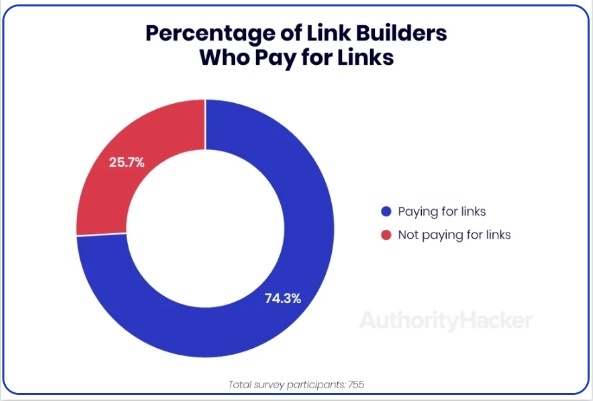
Źródło: https://www.authorityhacker.com/link-building-survey/
Znaczenie reputacji domeny w pozycjonowaniu
Efekt pozycjonowania, szybkość uzyskania oczekiwanego, zależy od reputacji Twojej domeny. Zgłaszają się do nas klienci, których strony były promowane poprzez spam. Kupili ogromne ilości niskiej jakości odnośników, dodawali bezwartościowe treści, upychali słowa kluczowe, ukrywali content na stronie. Przez łamanie wytycznych Google ich domeny utraciły autorytet i obecnie przywrócenie właściwego toru rozwoju może wymagać bardzo dużej inwestycji. Na autorytet wpływa wiele czynników, takich jak:
- Wiek domeny – adresy z długą historią mają zwykle większy autorytet i wiarygodność niż nowsze.
- Liczba i jakość linków przychodzących – odnośniki z witryn o wysokiej jakości sygnalizują wyszukiwarkom, że strona, do której prowadzi link, jest również wartościowa.
- Jakość treści witryny – wysokiej jakości, bogata w informacje i dobrze napisana treść pomaga budować reputację witryny.
- Dane historyczne związane z domeną – jeśli domena była w przeszłości wykorzystywana do spamowania lub innych złośliwych działań, trudniej jest zbudować pozytywną reputację.
Dlatego warto inwestować wyłącznie w działania etyczne, nie wykorzystywać domeny do spamowania, gdyż długookresowo zawsze przyniesie to negatywne konsekwencje Tymczasem, mając dobrą reputację i dobrze wypozycjonowaną stronę, możesz głównie skoncentrować się na dodawaniu wartościowej treści, aby regularnie zwiększać widoczność witryny.
Miej również na uwadze, że budowanie reputacji domeny trwa. Przede wszystkim dlatego trudno o wysokie pozycje na konkurencyjne frazy, jeśli Twój serwis istnieje od niedawna. Dopiero z czasem, kiedy Google zaufa domenie, łatwiej przychodzi rozwijanie widoczności serwisu. Właśnie z tego powodu bardzo często sięga się po domeny, które z pewnych powodów nie zostały przedłużone przez dotychczasowych abonentów. Chodzi o takie adresy, które mają bardzo dobry profil linkowy i reputację.
Jak wykorzystywać wygasłe domeny?
Mogą one mieć ogromną wartość w pozycjonowaniu. Co sprawia, że warto korzystać z wygasłych domen? Sam fakt, że wygasła, nie daje oczywiście nic poza tym, że staje się możliwa do przejęcia. Wartościowa jest wtedy, gdy:
- Ma wysokiej jakości profil linków.
- Nie była wcześniej używana do spamowania.
Do znajdowania takich domen używa się różnych aplikacji, ale najpopularniejszym sposobem jest skorzystanie z serwisu Aftermarket. Problem tkwi jednak w tym, że przejęcie wartościowej domeny jest bardzo trudne ze względu na dużą konkurencję. Jeśli się uda, to raczej na pewno będzie na nią więcej chętnych niż jeden i dojdzie do licytacji, tzn. domenę przejmie ten, kto więcej zapłaci. Oto przykłady zastosowania takich domen:
- Załóż blog zapleczowy – często nazywa się je PBN-ami. Może to być strona, z której będziesz linkować do pozycjonowanego serwisu. Co więcej, wartościowa domena po dodaniu artykułów może szybko zacząć rankować i pozyskiwać ruch, a to oznacza potencjał monetyzacji. Jednak licz się z tym, że wykorzystanie domeny jako PBN-a może się z czasem skończyć wyzerowaniem jej reputacji, tzn. linki z niej nie będą przenosić mocy SEO.
- Przejmij linki tej domeny – ustal, jakie odnośniki prowadzą do danej witryny. Przygotuj wysokiej jakości materiały dotyczące zagadnienia, które opisane było na tej witrynie pod linkowanymi URL-ami. Do ustalenia zawartości tej treści możesz wykorzystać narzędzie Way Back Machine, w którym znajdują się kopie witryn z różnych okresów. Następnie skontaktuj się z właścicielami witryn, na których znajdują się linki. Poinformuj ich, że odsyłacze prowadzą do nieistniejącego zasobu i poproś o podlinkowanie materiału na Twojej stronie.
- Przekierowanie 301 – przekieruj domenę na stronę, którą pozycjonujesz. Ta metoda nie przynosi tak dobrych efektów jak lata temu, ale w dalszym ciągu może pozytywnie wpłynąć na widoczność Twojej witryny w wynikach Google.
- Założenie strony – jak wspomnieliśmy, nowa domena musi dopiero zbudować sobie autorytet w Google, ale jest sposób, aby pominąć ten etap. Oczywiście, chodzi o wykorzystanie wygasłej domeny, która ma dobrą reputację i solidny profil linkowy. To jednak nie oznacza, że w każdym przypadku użycie takiej domeny jest gwarancją sukcesu. Efekt zależy od wielu czynników m.in. czasu, przez który strona nie działała. Warto również odbudowywać wcześniejszą strukturę witryny – szczególnie jeśli chodzi o te materiały, które były najmocniej podlinkowane.
W naszych kampaniach wykorzystujemy wygasłe domeny w różny sposób. W każdym przypadku dostosowujemy podejmowane działania do danego projektu. Dzięki domenom o wysokiej reputacji jesteśmy w stanie szybko zapewnić klientom ruch z Google. Korzystamy ze spersonalizowanych narzędzi, które ułatwiają nam przechwytywanie wartościowych adresów.
Jak wybrać agencję, która wypozycjonuje stronę?
Warto poświęcić czas na analizę ofert i przemyśleć, z kim chcesz podjąć współpracę. Nie podejmuj decyzji pochopnie, daj sobie czas na analizę. O co pytać i co powinno mieć znaczenie przy wyborze?
- Doświadczenie agencji – stawiaj na sprawdzonych specjalistów, którzy działają w branży od lat i możesz to łatwo zweryfikować. Taka firma przede wszystkim powinna mieć liczne case studies, które może zaprezentować jako potwierdzenie jakości realizowanych usług. Możesz się spotkać też z odpowiedziami, że agencja SEO nie ma prawa podawać takich danych ze względu na umowy zawarte z klientami. Z pewnością jednak znajdziesz takie, które zaprezentują Ci wyniki osiągnięte w dotychczasowych kampaniach. Jeśli interesuje Cię nasza oferta, pokażemy Ci nasze przykładowe realizacje.
- Opinie o firmie – jeśli nie możesz ich znaleźć, to sygnał, że lepiej nie ryzykować. Firma SEO powinna mieć m.in. Profil Firmy w Google czy profile w serwisach społecznościowych. Nie oczekuj, że wszystkie opinie będą pozytywne. Jeśli trafisz na negatywne, to zwróć uwagę, jak agencja na nie odpisywała. W przypadku gdy jednak odsetek takich komentarzy jest duży, lepiej nie bierz pod uwagę współpracy z taką firmą.
- Czas obowiązywania umowy – zabezpiecz się i wybierz umowę z krótkim okresem wypowiedzenia. Zawieranie kilkuletniego kontraktu jest bardzo ryzykowne, może Cię narazić na koszty i jednoczesny brak oczekiwanych wyników pozycjonowania strony. Zdarza się, że firmy oferują kilka miesięcy realizacji usług za darmo, ale jednocześnie wymagają długiej umowy. Taki wybór może być bardzo ryzykowny.
- Co obejmuje raport i jak często będziesz go otrzymywać? Przeważnie klient otrzymuje go po zakończeniu kolejnego miesiąca rozliczeniowego i taka częstość jest wystarczająca. Jeśli chodzi o zawartość raportu, to powinien on obejmować informacje o przeprowadzonych w danym miesiącu pracach, zmianie widoczności w Google, pozyskanych odnośnikach czy działaniach optymalizacyjnych. Agencja SEO nie powinna ukrywać, gdzie opublikowała linki, a to się niestety często zdarza. Firmy usprawiedliwiają się, że nie chcą podawać adresów swojego zaplecza. Dlatego przed zawarciem umowy zapytaj, czy otrzymasz listę pozyskanych odnośników.
- Co obejmują działania – powinna to być optymalizacja techniczna, rozwój contentu i link building. To kluczowe elementy w SEO. Zdarza się też, że agencja wykonuje tylko część prac, a zlecający podejmuje się pozostałych działań. W takich przypadkach jednak wymaga to ścisłej współpracy i doskonałej komunikacji, aby osiągnąć sukces.
- Czy do Twojej dyspozycji będzie indywidualny opiekun kampanii? Nie może być tak, że na ewentualne pytania dotyczące działań będziesz czekać wiele dni. Musisz mieć możliwość kontaktu telefonicznego i innymi kanałami.
- Po jakim czasie możesz oczekiwać wyników? Zdarza się, że firmy obiecują rezultaty, które w danym przypadku są nierealne do osiągnięcia. Jeśli agencja twierdzi, że Twoja nowa strona po miesiącu współpracy będzie zajmować wysoką pozycję na konkurencyjne słowo kluczowe, to coś tutaj jest nie tak. Przyjrzyj się bliżej ofercie. Być może firma próbuje Cię nakłonić do długoterminowej umowy.
- Jaka forma rozliczenia? Najczęściej to stały abonament z ewentualną premią za osiągnięcie danego celu. Opcja rozliczenia za efekt jest rzadko praktykowana i może mieć sens jedynie w przypadku wybranych projektów – głównie firm, które mają ofertę kierowaną do lokalnych odbiorców.
- Czy możesz otrzymać wstępną analizę strony? Profesjonalna agencja nie będzie mieć problemów z podstawową i bezpłatną analizą Twojej witryny pod względem SEO.
- Cena – z pewnością masz określony budżet na działania. Dopasuj go rozsądnie. Nie ma problemów, aby go zwiększyć, jeśli kampania będzie przynosić efekt. Natomiast ustal go na takim poziomie, aby bez problemów podołać temu wydatkowi. Na pewno nie wybieraj oferty na podstawie najniższej ceny. Jeśli dana propozycja odbiega od pozostałych, może oznaczać, że jest podejrzana.
Takie podejście do wyboru agencji SEO minimalizuje ryzyko podjęcia nietrafionych decyzji. Warto przeprowadzić szczegółową analizę oferty, a tym bardziej nie zawierać pochopnie długoterminowej umowy.

